|
|
John Sanders – Deputy Sheriff
Adair County Sheriff’s Office
The evening of Tuesday, September 14, 1915, Deputy Sheriffs John Sanders, and Charley Sanders went to a Stomp Dance in the north section of Adair County near Chewey where it was reported that whiskey was being freely distributed. The deputies arrested several bootleggers including Tom Smartt. A gun fight broke out and several people were wounded including both deputies. Deputy Sheriff John Sanders died of his wounds at the scene as did two other people. Deputy Sheriff Charlie Sanders survived his wounds.
Tom Smartt, 53, was arrested for the murder of Deputy Sheriff John Sanders. Tom Smartt was tried twice in October, the first trial ended in a hung jury. The second trial ended in Tom Smartt being found guilty and he was sentenced to life in prison.
The burial site of Deputy Sheriff John Sanders is unknown.
OLEM – 9N-2-19 NLEOM –
September 12, 2021
|
|
|
|
|
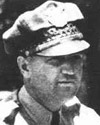
|
Elmer Lee Sartor - Patrolman
Oklahoma City Police Department
Elmer Lee Sartor had joined the Oklahoma City Police Department on March 8, 1932.
On Monday, August 20, 1934, Officer Elmer Sartor was a motorcycle officer escorting U.S. Postmaster General James Farley from Oklahoma City to Wichita, Kansas. On Highway 77 south of Ponca City, one of the wheels of Patrolman Elmer Sartor’s motorcycle locked up and caused him to crash. The twenty-eight-year-old Oklahoma City officer died a few hours later from a fractured skull.
Elmer Sartor is buried in Memorial Park Cemetery, Oklahoma City, Oklahoma County, Oklahoma.
OLEM – 7N-1-7 (Sarton) NLEOM – 29W14
February 11, 2022
|
|
|
|
|

|
Hilton Elmore Schorre - Deputy U S Marshal
U.S. Marshal Service
On Tuesday, March 30, 1971, Deputy Marshal Hilton Schorre, and his Guard Mercello Moya had transported three prisoners from Texas to the El Reno Federal Prison and were then transporting two other prisoners from El Reno to the Federal Prison in Texarkana, Texas. About 4:45 p.m. they were south bound on I-35, seven miles north of Pauls Valley, Oklahoma, when a truck pulled off the shoulder of the highway in front of them. Deputy Marshal Schorre swerved to avoid the truck, lost control of his car, crossed the center median and struck a north bound vehicle. Deputy Marshal Hilton Schorre, 58, was killed almost instantly. Guard Mercello Moya and both prisoners died a few hours later in a Pauls Valley hospital. The driver of the north bound car survived his injuries. Deputy Marshal Hilton Schorre joined the U.S. Border Patrol in 1942 and later transferred to the U.S. Department of Agriculture before becoming a Deputy U.S. Marshal in 1952.
Deputy Marshal Schorre lived in Corpus Christi, Texas was survived by his wife Marion two sons and a daughter.
Hilton Schorre is buried in Seaside Memorial Park Cemetery, Corpus Christi, Nueces County, Texas.
OLEM – 1N-2-10 NLEOM – 12E15
February 11, 2022
|
|
|
|
|
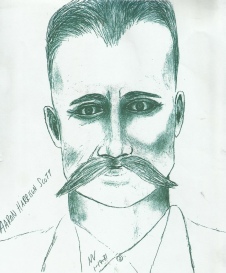
|
Aaron Harrison Scott – Deputy Special Officer
Bureau of Indian Affairs
U.S. Department of the Interior
During the evening of Monday, June 22, 1925, Special Officer Aaron Scott was attempting to arrest a bootlegger named O.Z. McKenzie in nearby Clayton. McKenzie resisted arrest and shot Officer Aaron Scott four times during the encounter. Deputy Special Officer Aaron Scott died from his wounds.
O. Z. McKenzie surrendered to Pushmataha County Deputy Sheriff Ben Bedford and was jailed in Antlers. When Officer Aaron Scott’s gun was examined, it showed that the gun had fired one cartridge and misfired on four.
Officer Aaron Scott was survived by his wife Amanda and five children.
Aaron Scott is buried in Clayton Cemetery, Clayton, Pushmataha County, Oklahoma.
O. Z. McKenzie’s trial, in November of 1926, ended in a hung jury and he was acquitted.
In July 2012 the U.S. Highway 271 Kiamichi River Bridge one mile south of Clayton was renamed the Aaron Harrison Scott Memorial Bridge.
OLEM – 9S-2-5 NLEOM – 7E27
February 11, 2022
|
|
|
|
|
|
John H. Scott - City Marshal
City of Quinton
On Wednesday, September 29, 1918, at about 6:00 p.m. Officer Moody and Assistant Chief Sam Scott, of the Chickasha Police Department and Grady County Deputy Sheriff Walter Jones went to the Rock Island bridge looking for two deserters from the Fort Sill Army base. When the deserters were spotted, the officers yelled for them to surrender but instead of surrendering they began running away. Deputy Sheriff Walter Jones was able to capture Fred E. Woodall, one of the deserters. Fred Woodall was left in the custody of Chief Sam Scott while Officer Moody and Deputy Sheriff Jones pursued the other man, Virgie Kitson. Their efforts were in vain, and the other man escaped.
When the officers returned, they discovered the other deserter Fred Woodall gone and Chief Sam Scott shot through the liver and kidneys. Assistant Chief Scott died from his wounds on October 4th..
Fred E. Woodall was captured on October 2nd near Ninnekah. Fred Woodall convinced officers that the other deserter, Virgie Kitson, was the one who shot Chief Sam Scott.
Virgie Kitson was later arrested, tried, and convicted of murdering Assistant Chief Sam Scott and was sentenced to life in prison.
Assistant Chief Sam Scott, who had only been on the Chickasha police force for about two months when he was shot, would have turned 41 on November 7th, was survived by his wife and son and is buried in Rosehill Cemetery, Chickasha, Grady County, Oklahoma.
Until February 2022 Assistant Chief Sam H. Scott’s grave remained unmarked.
OLEM – 5N-5-21 NLEOM – 26W32
February 11, 2022
|
|
|
|
|
|
Sam H. Scott - Assistant Chief of Police
Chickasha Police Department
Sam H. Scott was born November 7, 1877, at Winston-Salem, Forsyth County, North Carolina. Sam Scott married Mary Melbina Logan (Lewis) in Oklahoma in 1904. Mary Melbina had been married to a man named Logan before marrying Sam Scott and had a teenage daughter, Zoe Ida Logan, 14.
On Wednesday, September 29, 1918, at about 6:00 p.m. Officer Moody and Assistant Chief Sam Scott, of the Chickasha Police Department and Grady County Deputy Sheriff Walter Jones went to the Rock Island bridge looking for two deserters from the Fort Sill Army base. When the deserters were spotted, the officers yelled for them to surrender but instead of surrendering they began running away. Deputy Sheriff Walter Jones was able to capture Fred E. Woodall, one of the deserters. Fred Woodall was left in the custody of Chief Sam Scott while Officer Moody and Deputy Sheriff Jones pursued the other man, Virgie Kitson. Their efforts were in vain, and the other man escaped.
When the officers returned, they discovered the other deserter Fred Woodall was gone and Chief Sam Scott shot through the liver and kidneys. Assistant Chief Scott died from his wounds on October 4th.
Fred E. Woodall was captured on October 2nd near Ninnekah. Fred Woodall convinced officers that the other deserter, Virgie Kitson, was the one who shot Chief Sam Scott.
Virgie Kitson was later arrested, tried, and convicted of murdering Assistant Chief Sam Scott and was sentenced to life in prison.
Assistant Chief Sam Scott, who had only been on the Chickasha police force for about two months when he was shot, would have turned 41 on November 7th.
Sam Scott was survived by his wife Mary and young son, Thurman S., 4.
Sam Scott is buried in Rose Hill Cemetery, Chickasha, Grady County, Oklahoma next to his wife Mary who died in 1939.
Until May 18, 2023, Assistant Chief Sam H. Scott’s grave remained unmarked.
OLEM – 5N-5-21 NLEOM – 26W32
June 13, 2023
|
|
|
|
|
|
Sam Scott - Captain
Creek Nation Lighthorse, Indian Territory
Between 1878 and 1883, a civil war erupted between factions of the Creek Nation. One faction, the Sands men were a gang of about 400 led by the outlaw Dick Glass. The other faction was the Creek National Constitutional Party. In late July a party of about seventy-five Creek National Constitutional Party Lighthorse visited the neighborhood of the Sands men, in the northwestern part of the Creek Nation, and arrested a notorious character. They placed the notorious character in the charge of Captain Sam Scott and three other Lighthorse including Joe Barnett, a colored Creek Lighthorse.
On Sunday, July 30, 1882, about daylight, a company of Sands men attacked the four Lighthorse, rescued their prisoner and murdered Captain Scott in cold blood. Captain Scott was held by the hands with his arms stretched out by men on either side of him while others filled his body with bullets. His body was pulled and torn and shot until it was nearly unrecognizable. Officer Joe Barnett, in trying to aid his captain was also fatally shot. In April of 1883, several men were captured and taken to their respective districts to be turned over to the civil authorities for trial. One of the men, He-ne-ha Chupko, tried to escape but the guards fired on him, killing him instantly. He was one of the leaders in the killing of Captain Sam Scott and his officer, Joe Barnett.
OLEM – 2N-3-3 NLEOM – 34E18
|
|
|
|
|
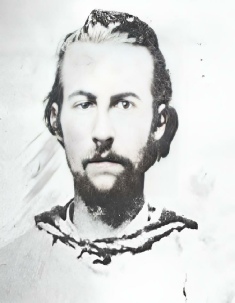
|
George W Selvidge - Posse, Deputy U S Marshal
U.S. Marshal Service
George Selvidge was one of eleven people killed and as many as nineteen wounded on Monday, April 15, 1872, at the Whitmire Schoolhouse east of Tahlequah, near the modern town of Christie in Adair County in the Going Snake District of the Cherokee Nation.
Zeke Proctor was being tried by the Cherokee Nation at the schoolhouse for accidentally killing a widow named Polly Beck Hildebrand. The relatives of Polly convinced the federal court at Fort Smith to intervene in the case. The U.S. Commissioner issued an arrest warrant for Zeke Proctor on a charge of “assault with intent to kill” to Deputy U.S. Marshals Jacob G. Owens and Joseph S. Peavey. The Deputy Marshals led a deputized posse including friends and relatives of Polly Beck Hildebrand to the schoolhouse. As the federal posse entered the schoolhouse a massive gun battle erupted. Posse members Jesse “Black Sut” Beck, Samuel Beck, William Hicks, George Selvidge, James Ward, and Riley Woods were shot and killed that day. Deputy U.S. Marshal Jacob Owens and Posse William Beck were also wounded and died the next day, April 16th from their gunshot wounds.
George Selvidge was survived by his wife Sabra (Beck) and son John. George is buried in the Beck Cemetery, Colcord, Delaware County, Oklahoma.
OLEM – 9N-2-14 NLEOM – 28E25
April 15, 2022
|
|
|
|
|
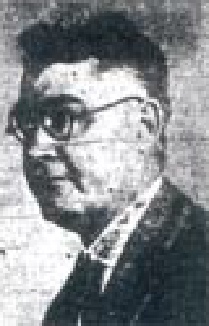
|
James Alexander “Daddy” Sewell - Deputy Sheriff
Tulsa County Sheriff’s Office
One of the best known and most popular deputy sheriffs in 1925 was a man named James A. Sewell. James Sewell came to the Tulsa County Sheriff’s Office from Lawrence County, Missouri, in the pioneer days. James Sewell was a cotton buyer in Bixby until Bob Sanford was elected Sheriff in 1923. James Sewell became a deputy sheriff by a personal selection by newly elected Sheriff Bob Sanford. To all of his fellow deputies, he was known simply as “Daddy” Sewell. Deputy Sheriff Sewell was the transportation deputy for the Tulsa County Sheriff’s Office. James Sewell lived in Bixby, with his wife, Rebecca, and four children, and was 56 at the time of his death. James Sewell was described as “one of the most courageous and kindly-hearted men who ever wore a star.” On Tuesday, March 24, 1925, Deputy Sheriff James Sewell was transporting three inmates to their respective correctional facilities. After dropping off Daniel Scott, 14, at the Pauls Valley Industrial School, Deputy Sheriff James Sewell proceeded to Chickasha, where he customarily stopped overnight on his trips to the Oklahoma Reformatory in Granite where he was taking Howard Love, 16, and Ernest Hughes, 20. Before being transported back to Granite, Ernest Hughes was overhead to say he “was going to pull something” if he got the chance. When Deputy Sheriff James Sewell and his prisoners were about fifteen miles east of Chickasha, Howard Love claimed that while Deputy Sheriff Sewell was taking off his coat, Ernest Hughes grabbed Sewell’s pistol and shot him to death. Deputy Sheriff James Sewell staggered from the car and fell to the ground. Howard Love claimed that Deputy Sheriff Sewell’s last words were, “It’s a shame to do an old man this way.” The two prisoners then shot the handcuffs off their wrists and placed Deputy Sheriff James Sewell’s body in his county car. The pair then drove to a nearby farmhouse and placed the body of James Sewell in the front yard.
The entire Tulsa County Sheriff’s office was stunned at the news of “Daddy” Sewell’s death. The inmates in the County Jail even mourned the death of Deputy Sheriff Sewell. Most of the inmates had known “Daddy” Sewell due to his assignment as transportation deputy. The inmates knew him for “his kindness in handling them and his sympathy for unfortunates generally.”
Both Howard Love and Ernest Hughes were later apprehended after a statewide manhunt and charged with murder in Grady County where the shooting had occurred. Both defendants blamed each other for shooting Deputy Sheriff Sewell, but Howard Love would be convicted, and sentenced to life in prison.
Deputy Sheriff James Sewell was survived by his wife Rebecca and is buried in Bixby Cemetery, Bixby, Tulsa County, Oklahoma.
OLEM – 3S-3-8 NLEOM – 17W22
February 11, 2022
|
|
|
|
|
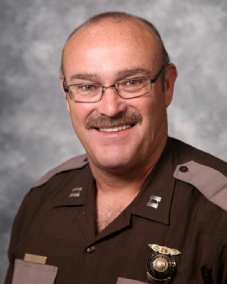
|
Jeffery Wade “Jeff’ Sewell - Captain
Oklahoma Highway Patrol
Jeffery Sewell, 58, had been an Oklahoma Highway Patrol (OHP) Trooper thirty-two years, graduating from the OHP Academy in July 1988. Young Trooper Jeffery Sewell was wounded in the line of duty in November 1988 while serving in Roger Mills County. Sewell served in many capacities as a Trooper over the years reaching the rank of Captain.
Captain Sewell was assigned as the Commander of the OHP Officer Assistance Program. His duties required that he make contact either by phone or in person or both with members of the OHP suffering distress from work or non-work-related incidents. There were thirty-nine instances documented where Captain Sewell may have been potentially exposed to the Covid-19 virus during the month of August while performing his duties with the OHP. Captain Sewell was hospitalized September 5, 2020, in the Texoma Medical Center in Denison, Texas due to
Covid-19 where he remained until his death September 26, 2020.
Captain Jeffery Sewell was survived by his wife of thirty-eight years, Ellen, and two married daughters, Jennifer Allen, and Randi Sue Hauff.
Jeffery Sewell is buried in Green Meadows Cemetery, Atoka, Atoka County, Oklahoma.
OLEM – 10S-3-17 NLEOM – 29E32
May 17, 2021
|
|
|
|
|
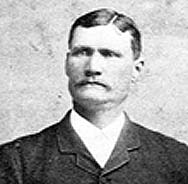
|
Lafayette "Lafe" Shadley - Deputy U.S. Marshal / Chief of Police
U.S. Marshal Service / Osage Nation Police
In 1892, while serving as a Deputy U.S. Marshal out of the federal court in Guthrie, Lafayette Shadley had been involved in a gunfight with Doolin gang member “Dynamite Dick” Clifton in the Osage Nation. Although Clifton was able to escape, Deputy Marshal Shadley had wounded him in the neck. The next time they met, the fortunes would be turned.
In late August 1893, Bill Dalton, Bill Doolin, George “Bitter Creek” Newcomb, Red Buck Weightman, Dynamite Dick Clifton, Tulsa Jack Blake and Roy “Arkansas Tom” Daugherty, members of the Dalton/Doolin gang were reported to be in Ingalls, a small town ten miles east of Stillwater in Payne County, Oklahoma Territory.
On Friday, September 1, 1893, two covered wagons entered Ingalls. Concealed inside them was the ominous number of thirteen Deputy U.S. Marshals: Thomas J. Hueston, Lafayette Shadley, Dick Speed, Ham Hueston (Tom’s brother), Henry Keller, George Cox, M. A. Iauson, H. A. Thompson, John Hixson, Jim Masterson (Bat’s brother), Doc Roberts, Ike Steel and Steve Burke.
Seeing Bitter Creek Newcomb leading his horse down the street, Deputy Marshal Dick Speed opened the battle by wounding Newcomb. George “Bitter Creek” Newcomb drew up his Winchester just as Deputy Marshal Dick Speed threw up his rifle and fired. Dick Speed’s bullet shattered the magazine on George “Bitter Creek” Newcomb’s Winchester driving part of it into his leg. “Bitter Creek’s” first shot went wild, and he was unable to get off a second shot with the damaged gun. Deputy Marshal Dick Speed stepped up and took aim for a final shot at “Bitter Creek.” In the meantime, Roy Daughtery also known as “Arkansas Tom” heard the shots, ran to his second-floor OK Hotel room window in time to see Deputy Marshal Dick Speed take aim at George Newcomb. “Arkansas Tom” quickly shot Deputy Marshal Dick Speed, hitting him first in the shoulder and then killing him instantly with a second shot. Roy Daugherty then shot Deputy Marshal Thomas Hueston twice, once in the left side and once in the bowels.
Deputy Marshal Lafayette Shadley, 49, was shot three times while trying to climb through a fence by either Roy Daugherty or Bill Dalton or both. Roy Daugherty was arrested that day, but the rest of the gang escaped. Deputy Marshal Thomas Hueston died the next day on September 2nd. Deputy Marshal Lafayette Shadley died the day after that on September 3rd.
Lafayette Shadley was survived by his wife Malinda and two adult children Mary and William. He is buried in Mount Hope Cemetery, Independence, Montgomery County, Kansas.
OLEM – 5N-2-4 (Layfayette Shadley) NLEOM – 11E7
February 16, 2022
|
|
|
|
|
|
Martin Lyle “Bert” Shaffer – Retired Officer
Oklahoma City Police Department
Martin L. “Bert” Shaffer was born in Ringgold County, Iowa, on November 19, 1881. Martin Shaffer joined the Oklahoma City Police Department on April 11, 1923. Martin Shaffer served as a Patrolman in the Scout Car Division for the next seventeen years. On August 21, 1940, Martin Shaffer transferred to the Traffic Division.
On September 25, 1944, Officer Martin Shaffer was directing traffic at First Street (now Park Avenue) and North Broadway when he stepped backwards to move out of the way of a passing streetcar. Unfortunately, in stepping backwards Officer Shaffer stepped into the path of a streetcar going the opposite direction and was struck by it. Officer Martin Shaffer’s injuries required surgery to his right shoulder. The next year, on May 1, 1945, Martin Shaffer retired from the Oklahoma City Police Department after twenty-two years of service.
After retiring, Martin Shaffer worked for different companies as a night watchman. On Wednesday, February 1, 1950, Martin Shaffer, 68, had been the night watchman for the Oklahoma City Disposal Plant located a half a mile east of Eastern Avenue on Northeast Fourth Street for six months. Shortly after midnight that Wednesday, other workers at the plant observed a car pull into the plant entrance and night watchman Martin Shaffer approached the car. Witnesses stated they saw a man get out of the car and knock Shaffer to the ground. Witnesses then heard six shots before the car sped off.
Oklahoma City Detectives soon found Shaffer laying on the ground shot in the chest, twice in the abdomen, once in the left thigh and once in one wrist. The wounded Shaffer was able to tell the officers that his assailants were three young white men in a late model Hudson with Wyoming license plates. Shaffer’s gun was also missing. The detectives transported Shaffer to the hospital where he died shortly after arriving.
Within a few hours, two men were stopped in a 1949 green Hudson with Wyoming plates on NW 39th Street near Lake Overholser. One of the men, Jearell “Buddy” Hathcox, 36, had Martin Shaffer’s gun on him. Clay Wallace Ward, 32, was also arrested in the Hudson. The next day a local bootlegger, Lamon H. Barnett, 32, was arrested at his home. Lamon Barnett turned state’s witness. Barnett testified that the three men had been driving around when the driver, Clay Ward, became lost and drove into the disposal plant to turn around.
When night watchman Shaffer told the men to get out of the Hudson that he intended to search them. As Martin Shaffer searched Clay Ward, “Buddy” Hathcox attacked Shaffer, disarmed him, and shot him.
Jearell “Buddy” Hathcox was convicted of the murder of Martin Shaffer and died in Oklahoma’s electric chair on July 27, 1951.
Martin Shaffer is buried at Oak Grove Cemetery, Perkins, Payne County, Oklahoma.
OLEM – 7N-3-22
February 16, 2022
|
|
|
|
|
|
W. Richard “Dick” Shaver - Deputy U.S. Marshal / City Marshal
U.S. Marshal Service / City of Boley
W. Richard “Dick” Shaver was first appointed as a Deputy U. S. Marshal on August 25, 1890 and served as a Deputy U. S. Marshal for the next fifteen years. “Dick” Shaver was also serving his first week as the first City Marshal of Boley the evening of Monday, August 14, 1905.
Deputy Marshal “Dick” Shaver, 35, went out earlier in the day to three miles south of Boley to Andy Simmons’ house to arrest him for horse stealing. No one was home when Deputy Marshal Shaver arrived, so he spent the day checking the area for Andy Simmons.
About 8:00 p.m. that evening Deputy Marshal Shaver stopped by a neighbor of Simmons named George Johnson and was sitting on his horse about twenty feet from the fence of George Johnson talking to Johnson, when Dick Simmons, Andy’s brother, raised up from behind the fence and fired at Deputy Marshal Shaver with a Winchester rifle striking him in the lower back with the bullet exiting his lower stomach. Deputy Marshal Shaver, a noted marksman, fell from his horse but was able to draw his gun and return fire instantly killing his assailant, Dick Simmons, before he himself died about thirty minutes later.
Deputy Marshal W. Richard “Dick” Shaver was survived by his wife and four small children and is buried in Boley, Oklahoma, however the exact location of his grave is unknown
At 2 p.m. on Thursday, October 5, 2006, the portion of State Highway 62 that runs through the town of Boley, OK was dedicated as the “W. R. Shaver Memorial Highway.” It was the first time that Oklahoma had dedicated a roadway in honor of a fallen Afro-American law enforcement officer.
OLEM – 4S-3-15 NLEOM – 13E24
August 14, 2021
|
|
|
|
|
|
Lester Arthur (Chester) Shearhart - Chief of Police
Vinita Police Department
On the night of Friday, May 4, 1945, Chief Lester Shearhart and two other officers went to the farmhouse of Silas Hardrick. The officers were searching for a forgery suspect. When they arrived at the farmhouse, Silas Hardrick told the officers the man they were looking for was in the barn behind the house. While the officers went to the barn, Silas Hardrick came out of the house and hid in a ditch with a twelve-gauge shotgun. Locating no one in the barn, Chief Lester Shearhart came back to the front of the house. As Chief Shearhart came back around to the front of the house, Silas Hardrick shot him in the heart, wounding him fatally. Chief Lester Shearhart died thirty minutes later at a hospital in Vinita. Silas Hardrick was arrested by the other two officers and charged with the murder of Chief Shearhart.
Chief Lester Shearhart, 44, was survived by his wife Cleotia, four sons and one grandchild. Shearhart was serving the remainder of the term of the previous Chief of Police who had resigned. Lester Shearhart had been elected to the Chief’s position the previous March and had been due to take office to begin serving his own term on May 7t
Lester Shearhart is buried in Fairview Cemetery, Vinita, Craig County, Oklahoma.
OLEM – 7N-2-26 NLEOM – 46W15
March 8, 2022
|
|
|
|
|
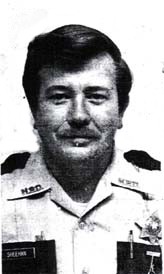
|
David J. "Johnny" Sheehan - Detective
McAlester Police Department
On Thursday morning, July 30, 1981, McAlester Police Department Detective David Sheehan, 28, and Corporal Ronnie Fox, 38, were flying with Oklahoma Bureau of Narcotics and Dangerous Drugs Control Agent Billy Morgan, 29, as observers. Agent Billy Morgan was the plane’s pilot flying in a leased single-engine airplane looking for marijuana patches in Pittsburg County.
About 8:20 a.m. that Thursday morning the plane came out of a cloud bank and Agent Billy Morgan had to put the plane in a steep climb to avoid a mountain. During the climb both wings cracked, and the left wing fell off. The plane crashed in the foothills of the Jack Fork Mountains, six miles northeast of Daisy, just inside Pittsburg County killing all three officers instantly.
Detective David Sheehan was survived by his wife Shirley and young daughter Michele and is buried in Oak Hill Memorial Park, McAlester, Pittsburg County, Oklahoma.
OLEM – 2N-1-18 NLEOM – 10W12
March 8, 2022
|
|
|
|
|
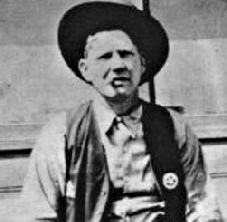
|
James Samuel “Sam” Shelley - City Marshal / Deputy Sheriff
City of Pershing / Osage County Sheriff’s Office
On Wednesday, May 11, 1921, about 8 p.m. Deputy Sheriff James Shelley stopped a new Dodge touring car that had just been reported stolen from Pawhuska as it approached Pershing. Deputy Sheriff Shelly was shot and killed by the two men in the car when he attempted to arrest them. After shooting Deputy Sheriff Shelly the men escaped in the stolen car, which was soon recovered, but the two men had escaped. A $1,500 reward was offered for the arrest and conviction of the person or persons who shot and killed Deputy Sheriff James Shelley.
Clyde “Red” Brandon, a member of the Kimes-Terrell gang, was later arrested and charged in connection with Deputy Sheriff James Shelley’s murder. Clyde Brandon soon escaped from the Osage County jail in Pawhuska but was arrested again on July 1, 1927, in Pawnee.
Deputy Sheriff James Shelley was survived by his wife Lillian and two sons, Loyd, 5 and Prentiss, 4.
James Shelley is buried in Fairlawn Cemetery, Stillwater, Payne County, Oklahoma.
OLEM – 9S-3-3 NLEOM – 15E24
May 11, 2021
|
|
|
|
|
|
Mason Edward Shelton – Officer
Oklahoma City Police Department
Mason E. Shelton’s name was probably included on the original Oklahoma Peace Officers Memorial (now the Oklahoma Law Enforcement Memorial) due to a page in the 1929 Oklahoma City Police Department Annual that listed fourteen officers whose families had collected on a $1,000 police insurance policy provided by an association of Oklahoma City Police officers for officers who died while on duty, even though they did not die in the line of duty. The 1929 Annual noted that six of the fourteen officer’s deaths “were due directly to the nature of their work.” By today’s standards, only two of the six officers, Briggs Chumley and A. L. Walton, meets the commonly accepted standards for a line of duty death. Nevertheless, the other four officers’ names were also engraved on the state’s Peace Officers Memorial when it was built in 1969. The other four officers are M. C. Hiatt, O. M. Milhollan,
M. E. Shelton and W. M. Slaton.
Mason Shelton, 42, had been a traffic officer with the Oklahoma City Police Department for about four years when he died from natural causes in an Oklahoma City hospital on Saturday, September 22, 1923.
Mason Shelton was survived by his wife Audrey and is buried at Fairlawn Cemetery, Oklahoma City, Oklahoma County, Oklahoma.
OLEM – 8S-3-7
January 29, 2022
|
|
|
|
|
|
Willis “Curley” Sheppard – Deputy Sheriff
Washington County Sheriff’s Office
About 11:30 p.m. the evening of Saturday, May 20, 1922, on a street in Smeltertown, Deputy Sheriff Willis Sheppard, 32, was accosted by two men, one of whom was Frank McJimpsey. McJimpsey was upset over the arrest of his sister, Mrs. Minnie White, some time earlier by Deputy Sheriff Sheppard. During the argument Frank McJimpsey, an escaped convict from Kansas, drew a gun and shot and killed Deputy Sheriff Willis Sheppard. McJimpsey and the other man then ran off. Frank McJimpsey was later arrested the end of September in Independence, Kansas. McJimpsey confessed to the murder of Deputy Sheriff Sheppard when arrested in Kansas and again later in writing after he was brought to Washington County for trial. Frank McJimpsey was tried in December 1922 and acquitted of the murder charge.
Deputy Sheriff Willis Sheppard was survived by his wife Mollie, two stepdaughters, Freda (13) and Francis (11) Fitzgerald, and his 5-year-old son Elmo.
Willis Sheppard is buried in White Rose Cemetery, Bartlesville, Washington County, Oklahoma.
OLEM – 9N-2-18 NLEOM – 51E31
March 8, 2022
|
|
|
|
|
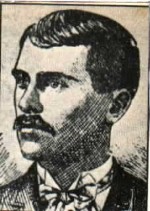
|
Charles Edwin "Ed" Short - Deputy U.S. Marshal Service / City Marshal
U.S. Marshal Service / Hennesey
Charley Bryant was regarded to be a restless and reckless individual who suffered with occasional dysfunctions. Bryant’s nickname was “Black-Faced Charley” because of powder burns from a gun fired too closely to his head resulting in permanently darkened spots on his face. Bryant always stated that when he died, he wanted to go “in one hell-firin’ minute of action.” Bryant had become acquainted with Emmett Dalton, Bill Doolin, “Bitter Creek” Newcomb and others while working on cattle ranches. He was involved in robbing the Texas Express with these men, headed by Bob Dalton, on May 9, 1891.
A couple months later another train robbery was in the works when Charley Bryant became quite ill having to take a room at a local hotel in Hennessey. Resident Deputy U.S. Marshal and Hennessey’s City Marshal Ed Short, was out of town when Charley Bryant became ill.
Ed Short had previously served as City Marshal of Woodsdale, Kansas during the Stevens County seat wars there in 1888 which resulted in the death of four other Kansas lawmen in what became known as “The Hayfield Massacre”.
When Deputy Marshal Ed Short returned to Hennessey he was told of the doctor’s new patient staying at the local hotel. Deputy Marshal Short took an opportunity to observe the patient with his knowledge and felt confident that he was one of the “wanted men.” With the cooperation of the hotel owner, Deputy Marshal Ed Short set forth to capture Charlie Bryant. By the time Bryant realized someone else was in his room, Deputy Marshal Ed Short had him covered and the suspect could not grab either of his guns. Charlie Bryant was denied his real “blazing moment of glory.”
Deputy Marshal Ed Short took Charlie Bryant on the Rock Island train the next evening heading for the federal jail at Wichita, Kansas. Deputy Marshal Short placed Bryant in the baggage car figuring this would be the safest place fearing the Daltons would try to rescue their cohort. Deputy Marshal Short surmised that if the Daltons did plan a rescue attempt, they would most likely attack at Waukomis, the first station north of Hennessey. When the train started to slow for that scheduled stop, Deputy Marshal Ed Short handed his gun to a mail clerk and asked him to watch Bryant while he stepped out on the platform for “a look out.” The mail clerk was not overly excited about his new assignment and when Ed Short left, he laid the pistol aside. Charlie Bryant immediately noticed and decided to make a break for freedom. Charlie Bryant, with great gusto, sprang to his feet and grabbed the unattended revolver. “Black-Faced Charley” Bryant rushed to the exit, opened the door and saw his target standing on the platform. Deputy Marshal Ed Short realizing the door was opening, turned and saw Charlie Bryant raising the pistol. Bryant fired then Deputy Marshal Short returned fire. Both men were shot. Each man continued shooting until Charlie Bryant fell and began sliding off the railroad car. Even though Ed Short was mortally wounded, he grabbed his prisoner and pulled him back on to the platform. When the train arrived at Waukomis, O. T. the evening of Sunday, August 23, 1891, the prisoner was dead and Deputy Marshal Ed Short was dying and died later that day.
Deputy Marshal Charles “Ed” Short was survived by his wife Frances and is buried in Greendale Cemetery, Osgood, Ripley County, Indiana.
OLEM – 5N-3-19 NLEOM – 14E4
August 23, 2021
|
|
|
|
|
|
J. H. Siler - Deputy Sheriff
Pawnee County Sheriff’s Office
On Sunday, May 21, 1899, Deputy Sheriff J. H. Siler, and Deputy Sheriff Albert Taylor attempted to arrest Jeff Breck on a warrant charging him with cattle stealing. A pitched gun battle followed during which Deputy Sheriff Siler’s horse was shot and killed. Deputy Sheriff J. H. Siler was fatally injured when his horse fell on him. Jeff Breck escaped.
The burial site of Deputy Sheriff J. H. Siler is unknown.
OLEM – 10N-1-17 NLEOM – 39E31
May 20, 2021
|
|
|
|
|

|
Kevin Simmons - Patrolman
Spencer Police Department
Kevin Simmons was born December 13, 1959, in Chicago, Illinois. His family later moved to Spencer, Oklahoma where Kevin Simmons graduated from Star Spencer High School in 1979. In November 1981 Kevin Simmons joined the Spencer Police Department.
Kevin Simmons would have turned twenty-three years old on Monday, December 13, 1982, instead it was his funeral.
On Thursday, December 9, 1982, at 2:30 a.m. Officer Simmons made a routine traffic stop in the 8600 block of NE 36th Street in Spencer. During the traffic stop the two occupants of the stopped pick-up truck attacked Officer Simmons and attempted to get control of his service revolver. Officer Simmons was able to shoot one of the men, Scott Moore, in the stomach before the pair took Officer Simmons’ service revolver from him and shot him. Officer Simmons died less than two hours later at 4 a.m. at Oklahoma Memorial Hospital in Oklahoma City. Authorities began searching for Tollie Earl Melvin, 25, and Scott L. Moore, 21, when their driver’s licenses were discovered in Officer Simmons uniform pants pocket at the hospital.
Officer Kevin Simmons had radioed the description and tag number of the pick-up truck he was stopping. The pick-up was registered to a Chickasha resident who said later that he had loaned the pick-up to Scott Moore.
Scott Moore was soon arrested at the Grady Memorial Hospital in Chickasha where he had gone to have his gunshot wound treated. Scott Moore was soon moved to an undisclosed Oklahoma City Hospital where he was under guard. Tollie Melvin was arrested without incident on Sunday, December 12, 1983, at a local Chickasha residence then transported to the Oklahoma County Jail. Tollie Melvin and Scott Moore were tried for the murder of Officer Kevin Simmons. The shooter, Tollie Melvin, was convicted and given a life sentence in prison where he died in June 1987.
Officer Kevin Simmons was survived by his mother, four brothers and five sisters. His body was transported back to Chicago to his mother for burial. The burial site of Kevin Simmons is unknown.
OLEM – 2N-1-24 NLEOM – 53W9
April 30, 2022
|
|
|
|
|
|
James A. Simms - Sergeant
Ardmore Police Department
Sergeant James Simms was the night desk sergeant for the Ardmore Police Department. At about 1:30 a.m. on Thursday, May 20, 1920, Sergeant Simms’ fifty-sixth birthday, two men, Claude Pruitt, and Dick Crotzer, arrived at the Police Station from a fishing trip to return a flashlight they had borrowed. Evidently, as a prank, Claude Pruitt and Dick Crotzer unloaded their only catch, a large opossum, on the floor of the office. The animal was dirty, and a nuisance and Sergeant Simms ordered it taken out. Claude Pruitt was reluctant to remove the animal, and Sergeant Simms ordered Patrolman Fred Emmerson to remove the animal and Claude Pruitt. Sergeant Simms seeing what he thought was a gun in Claude Pruitt’s pocket ordered Patrolman Emmerson to arrest Pruitt and take charge of the gun. Claude Pruitt immediately jumped into his car and drove off. Claude Pruitt turned the car around at the corner of A and First streets and came back to the police station. Sergeant James Simms came to the door and walked toward the car apparently intending to arrest Claude Pruitt. Pruitt warned Sergeant Simms not to come near the car, but Sergeant Simms kept walking toward it. Claude Pruitt drew a .32 caliber automatic handgun and fired nine shots, five of which struck Sergeant James Simms, killing him instantly. Two of the bullets barely missed Patrolman Emmerson. Claude Pruitt was immediately placed under arrest and taken to jail.
Sergeant James Simms was survived by his wife Mary Jane and four children who were preparing a birthday party for him that day.
James Simms is buried in Rose Hill Cemetery, Ardmore, Carter County, Oklahoma.
Newspaper reports listed Sergeant Simms first name as John. His first name was mistakenly engraved “David” on the Oklahoma Law Enforcement Memorial.
OLEM – 8S-3-11 (David) NLEOM –
|
|
|
|
|
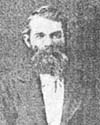
|
William H. Singletary - Deputy Sheriff
Washita County, O. T.
William Singletary was born near Andersonville, in Macon County, Georgia on March 18, 1850. William Singletary had moved to Brownwood, Brown County, Texas by 1877 where he married Sarah Emily “Sallie” Looney on December 9, 1877. The couple lived in Brown County until the fall of 1892 when they moved to Washita County, Oklahoma Territory and settled down near the Combs post office four miles west of present-day Sentinel.
On Saturday, May 6, 1899, Deputy Sheriff William Singletary attempted to subdue a drunken cattleman, Sid Davidson, to quell a disturbance in the town of Combs. Sid Davidson fatally shot Deputy Sheriff William Singletary and escaped. After dodging officers for several months, Sid Davidson finally surrendered himself but died from pneumonia before his murder trial began.
Deputy Sheriff William Singletary was widower, his wife Sarah Emily “Sallie” had died two years earlier from blood poisoning after a still childbirth.
William Singletary was buried beside “Sallie” next to a lilac bush in the Singletary Family Cemetery located on the southeast corner of a crossroads at the top of a hill on their land described as NW ¼, Section 19, Range 19, Township 8. William Singletary was survived by five minor children, four sons, Clarence Preston, Robert Alexander, Herman Leroy, and Ernest Rayfield and a daughter Ina Isola. Five other of their children had died in infancy.
OLEM – 5N-3-23 NLEOM – 56W24
April 30, 2022
|
|
|
|
|
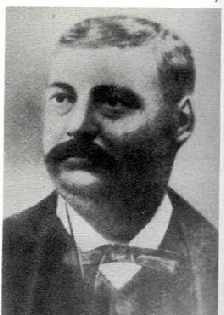
|
Samuel "Sam" Sixkiller - Deputy U.S. Marshal Service
U.S. Marshal Service / U.S. Indian Police
In 1880, Sam Sixkiller became the first appointed Captain of the United States Indian Police of the Five Civilized Tribes commanding forty officers in Muskogee.
In 1886, Sam Sixkiller became involved in a gunfight with Jess Nicholson in which Deputy Marshal Sam Sixkiller wounded Nicholson. Jess Nicholson eventually died from his wounds. Jess Nicholson was a friend of hot-tempered Dick Vann and once had been arrested for harboring Vann from the deputy marshals. Dick Vann was also arrested once by Deputy Marshal Sam Sixkiller during which Sixkiller allegedly kicked him. Dick Vann threatened to kill Deputy Marshal Sam Sixkiller for that kick.
On Christmas Eve, 1886, Deputy Marshal Sam Sixkiller, forty-four, was off duty and unarmed. Feeling a little under the weather, he made a trip to downtown Muskogee to pick up some medicine before taking his family to church. Deputy Marshal Sam Sixkiller was met by two dastardly malcontents bent on mayhem: Dick Vann and Alf Cunningham. Deputy Marshal Sam Sixkiller was stepping up on to the platform on the north side of the Patterson Mercantile Store. Dick Vann and Alf Cunningham, with a shotgun and pistol, without notice fired on Sam Sixkiller hitting him three times, once in the head. Deputy Marshal Sam Sixkiller fell to the ground mortally wounded, and Dick Vann and Alf Cunningham made good their escape on fast ponies into the Cherokee Nation. The Creek Nation filed charges against the two men, but Dick Vann was killed in a gunfight in Fort Gibson before he could be extradited. Alf Cunningham also escaped extradition and disappeared.
After the death of Deputy Marshal Sam Sixkiller, the United States legislature passed a bill, signed by the president, which made assault on an Indian federal policeman a federal crime.
Samuel Sixkiller was survived by his wife Francis and is buried in an unmarked grave in the Old Methodist Episcopal Church Cemetery, Muskogee, Muskogee County, Oklahoma.
In December 2010 Deputy U.S. Marshal / U.S. Indian Police Captain Samuel Sixkiller was inducted into the Oklahoma Law Enforcement Hall of Fame.
OLEM – 5N-1-12 NLEOM – 10E10
April 30, 2022
|
|
|
|
|
|
David Sizemore (Sigemore) - Deputy U.S. Marshal
U.S. Marshal Service
David Sizemore was a Creek Indian who was born in the Creek Nation of the Indian Territory. David Sizemore married Elinora Perryman, and they had one daughter, Jeaneta, who was born on March 11, 1874.
David Sizemore was administered the oath of office as a Deputy U.S. Marshal of the Western District of Arkansas at the Fort Smith Court on August 20, 1889. David Sizemore was also a commissioned police officer with the U.S. Indian Police headquartered in Muskogee, I.T.
David Sizemore was reported as having been killed on Thursday, July 31, 1890, on the Deep Fork Creek near Muskogee. The suspect was listed as Frank Hawkins, described both as a full blood Euchee Indian and a mixed blood Creek/Seminole, whom Deputy Marshal David Sizemore was trying to arrest for murder. Deputy Marshal David Sizemore had placed Frank Hawkins under arrest and was on his way to Fort Smith with Hawkins. Deputy Marshal Sizemore had set up camp for the night on the Deep Fork Creek close to Okmulgee. Frank Hawkins was able to grab a Winchester rifle and fire on Deputy Marshal David Sizemore shooting him several times before escaping. The federal and Creek authorities searched for Frank Hawkins but were unsuccessful. For four years Deputy U.S. Marshals searched for Frank Hawkins, coming close several times. Frank Hawkins always eluded the Deputy Marshals.
On Saturday, July 21, 1894, Frank Hawkins was shot and killed by two “friends,” Sam Chocota and Billy Narcome, who had been making plans to capture Frank Hawkins for the reward of five-hundred dollars.
Deputy Marshal David Sizemore was buried in Muskogee, but the exact location of his grave is unknown.
David Sizemore is not listed on the Fort Smith Honor Roll of slain deputy marshals. His surname is spelled “Sigemore” on the list maintained by the U.S. Marshals Service.
OLEM – 10N-3-13 NLEOM – 50W12 [Sigemore]
July 31, 2023
|
|
|
|
|
.jpg)
|
William Wails Slaton – Detective
Oklahoma City Police Department
William Slaton’s name, mistakenly engraved W M Slaton, was probably included on the original Oklahoma Peace Officers Memorial (now the Oklahoma Law Enforcement Memorial) due to a page in the 1929 Oklahoma City Police Department Annual that listed fourteen officers whose families had collected on a $1,000 police insurance policy provided by an association of Oklahoma City Police officers for officers who died while on duty, even though they did not die in the line of duty. The 1929 Annual noted that six of the fourteen officer’s deaths “were due directly to the nature of their work.” By today’s standards, only two of the six officers, Briggs Chumley and A. L. Walton, meets the commonly accepted standards for a line of duty death. Nevertheless, the other four officers’ names were also engraved on the state’s Peace Officers Memorial when it was built in 1969. The other four officers are M. C. Hiatt, O. M. Milhollan, M. E. Shelton and W. M. Slaton.
William Slaton was born in Alabama in 1866. His family moved first to Texas then to Oklahoma. William “Big Bill” joined the Oklahoma City Police Department in 1903 at the age of 36. William Sloan advanced through the ranks to the rank of Detective. By 1910 William Slaton was a Captain with the police department. Eventually falling from political favor, William Slaton was returned to the rank of Detective. William Slaton continued to be addressed as “Captain” as a sign of respect by the other officers.
On the afternoon of Sunday, August 1, 1924, Detective William Slaton died at his home 110 East 34th Street in Oklahoma City. Slaton’s obituary stated he had been losing weight for about two months and had spent the previous two weeks in Sulphur, Oklahoma taking a “rest cure”.
Detective William Slaton was survived by his wife Irene and three daughters, Bernice, 23, Murl, 15, and Hattie, 13.
Captain” William Slaton is buried at Fairlawn Cemetery, Oklahoma City, Oklahoma County, Oklahoma.
OLEM – 8S-3-14 (W M Slaton)
January 29, 2022
|
|
|
|
|
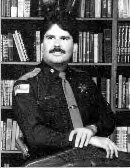
|
James Albert “Bert” Slay - Patrolman
Tulsa Police Department
Officer James Slay, 28, a seven-year veteran of the Tulsa Police Department, was injured on Tuesday, October 28, 1986, when his patrol car slipped out of gear, rolled forward from a parked position, and pinned Officer Slay against a beer truck. Officer Slay was issuing a traffic ticket to the driver of the beer truck at the time. The accident occurred east of Bartlett Square on 5th Street.
Police report stated that the driver of the beer truck backed the vehicle off Officer Slay and radioed for help. Officer James Slay died in a Tulsa hospital almost two weeks later Monday, November 10, 1986, from a blood clot resulting from a fractured pelvis he suffered in the accident on, October 28th. The officers at the department were “getting comfortable” with the fact that it had been a couple weeks since the accident and thought Slay would recover. Officer James Slay was working downtown patrol from the department’s Uniform Division West when the accident occurred. Officer Slay was preparing for the motorcycle training for the department and was to begin that training the following week.
Officer James Slay was survived by his wife, Marilyn, a 6-year-old daughter, Melissa, and 22-month-old son, Aaron, and is buried in Floral Haven Memorial Gardens, Broken Arrow, Tulsa County, Oklahoma.
OLEM – 2N-2-17 NLEOM – 53W10
November 9, 2021
|
|
|
|
|

|
George Greenville Smart - City Marshal
City of Marietta
SGeorge Smart was born in Dekalb, Texas, on April 8, 1877, and had been a resident of Marietta for twenty-five years at the time of his death.
Shortly after 4:30 p.m. Thursday, August 31, 1922, City Marshal George Smart, 45, and Love County Deputy Sheriff Stafford returned from a trip to the country looking for some stolen tires taken off a Ford car. The officers went to the Marietta Drug Store on Main Street, bought a drink, walked to the corner of the Post Office, sat down on the stair steps, and engaged in conversation with Mr. O. E. English.
For some reason City Marshal George Smart had left his gun in the drug store. In a short time, about 5:30 p.m., John Kelly, a prominent young businessman, walked up to City Marshal George Smart and said he wanted to talk to him. The two men walked west from the stairway to the west side of the door of the post office before they engaged in conversation. The next thing any witnesses saw was the two men were on the sidewalk in a struggle when a gun was fired and City Marshal George Smart was struck in the left groin, severing a large artery. The gun was a Smith and Wesson .38 caliber special. City Marshal George Smart was taken to his home where he died within the hour at about 6:15 p.m.
John Kelly immediately gave himself up to authorities and was placed in jail and held without bail. John Kelly testified at his bail hearing the next day that the trouble was over some remarks that City Marshal George Smart had allegedly made about John Kelly’s grocery firm’s negative stand on union labor. Many of John Kelly’s customers were railroad union workers and he felt the comments by City Marshal Smart would hurt his business.
City Marshal George Smart was survived by his wife and three daughters and is buried in Lakeview Cemetery, Marietta, Love County, Oklahoma.
OLEM – 4S-1-15 NLEOM – 10W27
May 3, 2022
|
|
|
|
|

|
Donald Wayne Smiley - City Marshal
Texhoma, Oklahoma
Donald Wayne Smiley was born September 28, 1931, in Stafford, Stafford County, Kansas to Hoyt Francis and Wilma Elaine (Sanders) Smiley.
Texhoma, Oklahoma is a town in southern Texas County in the Oklahoma panhandle and lies at the junction of State Highway 95 and U. S. Highway 54 on the Oklahoma-Texas border, twenty-four miles from Guymon, Oklahoma.
Just before 10 p.m. the evening of Tuesday, December 20, 1983, Texhoma City Marshal Donald Smiley, 52, was advised of a pickup setting in the west bound lane of travel on U.S. Highway 54 just inside the Texas state line. City Marshal Smiley stopped behind the pickup and got out to talk to the driver, Haskell Keenan. City Marshal Smiley radioed for assistance from Stratford, Texas officers indicating that the driver of the pickup was intoxicated. While City Marshal Donald Smiley was talking to Haskell Keenan a west bound tractor-trailer, driven by Dale Fields, swerved to miss the patrol unit and pickup truck, sideswiping both vehicles and striking City Marshal Smiley. City Marshal Donald Smiley was knocked into the east bound lanes of the highway and was on his hands and knees when he was struck by an east bound vehicle that kept going after striking City Marshal Smiley.
City Marshal Donald Smiley died at the scene.
Donald Smiley was survived by his wife Sharon Rae (Grow), seven daughters, Nancy, Kathrine, Regina, Lois, Mary, Brenda, Rebeka, and three sons, Robert, Paul, and Timothy.
Donald Smiley and is buried in the Texhoma Cemetery, Texhoma, Sherman County, Texas.
OLEM – 4N-3-13 NLEOM – 4W18
December 20, 2022
|
|
|
|
|
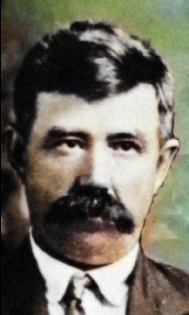
|
Elijah Columbas "Buddy" (Bill) Smith - Night Officer
Byars Police Department
About 6 a.m. on Sunday, June 27, 1937, the body of night officer Elijah C. “Buddy” Smith, 68, was discovered in the rear of the Milford Hardware store. Night Officer Smith had apparently surprised two burglars who had broken into the store and stolen several guns. Night Officer Smith was shot twice from behind and then beaten to death. An investigation determined that the murder occurred at approximately 2:30 a.m.
Elijah Smith, a carpenter by trade, was single and had been the Byars night police officer for about one month when killed.
Officer Elijah Smith is buried in Oak Hill Cemetery, Chetopa, Labette County, Kansas.
Two suspects were identified, W.H. Bybee, an escapee from Texas, and Hiram Prather. W. H. Bybee’s fingerprints were found on Night Officer Elijah Smith’s flashlight. W. H. Bybee was killed in a gunfight with Arkansas State Police near Monticello on July 20th.
Hiram Prather, while attempting an escape from the McAlester State Penitentiary in August of 1941, caused the death of Prison Warden Jess Dunn. Hiram Prather was executed in July of 1943 for Warden Jess Dunn’s death.
OLEM – 7N-2-2 (Bill) NLEOM – 41W26
June 27, 2021
|
|
|
|
|
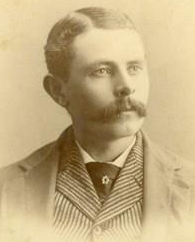
|
Frank E Smith - Sheriff
Caddo County
Frank Smith was commissioned as a Deputy US Marshal on March 22, 1886, in the Western District at Ft. Smith, Arkansas, serving under Marshal John Carroll. Smith later became Sheriff of Caddo County.
The morning of January 15, 1902, Sheriff Smith and his deputy, George Beck, went to a cabin three miles east of Fort Cobb to arrest members of the Casey Gang who had robbed a man the night before in Anadarko. The officers called for the men to come out but the officers were greeted by gunfire. The first volley wounded Deputy Beck four times in the chest and his left arm which was shattered, killing him instantly. Sheriff Smith was shot through the chest, leaving him fatally wounded, dying within a few minutes. The lawmen’s killers approached their victims robbing them of their possessions. The posse trailed the murderers in the snow where they eventually overcame the outlaws. One of the outlaws, Swofford, was killed and two others, Sam Casey, and Bill Wilson were captured near Wewoka, Indian Territory. The gang members, made up of a number of notorious outlaws, were wanted for horse stealing.
Prior to being Sheriff at Caddo, Frank Smith was Sheriff of Cleveland County. Frank was living in Norman, Oklahoma Territory, at the time of his death.
Update August 11, 2015
|
|
|
|
|
|
Frank Nettleton Smith – Former Sheriff / Chief
Love County Sheriff’s Office / Ardmore Police Department
Frank N. Smith was born Friday, August 12, 1870, in Corinth, Mississippi. In 1902 Frank Smith moved to Marietta, Oklahoma where he was a farmer until elected Sheriff of Love County in 1913. Frank N. Smith was re-elected as Sheriff of Love County continually until 1925. Frank N. Smith then served as Assistant Chief and Chief of the Ardmore Police Department. Later Frank N. Smith served as a Wheeler County Deputy Sheriff in Shamrock, Texas. In 1938 Frank N. Smith became the night supervisor at the State Hospital in Fort Supply until he retired due to ill health. In the fall of 1945, Frank moved in with one of his sons in Madill. The evening of December 17, 1945, Frank N. Smith suffered a stroke after returning from a movie and died at 2:30 a.m. the morning of Thursday, December 20, 1945.
Frank N. Smith was survived by his wife Effie and their three adult children, two sons and a daughter.
Frank N. Smith is buried in Woodberry Forest Cemetery, Madill, Marshall County, Oklahoma.
Frank N. Smith was not a law enforcement officer at the time of his death.
OLEM – 8S-5-18
July 29, 2022
|
|
|
|
|
|
George Smith - Territorial Deputy Sheriff
Grant County , I.T.
On the evening of Saturday, May 25, 1901, William Campbell, a local drunk, got in an argument with three other black men in front of the J.G. Knox Saloon. William Campbell was also known as “Nigger Bill.” William Campbell started to draw his gun but John Fisher, a gambler, drew his first and hit Campbell over the head. John Fisher dropped his gun while continuing to pistol-whip William Campbell.
Deputy Sheriff George Smith, who happened by at that moment, bent over to pick up John Fisher’s weapon. Before he could stand back up, William Campbell shot Deputy Sheriff George Smith over the left eye. William Campbell was overpowered and dragged to jail by a local banker who witnessed the shooting.
About midnight that night William Campbell was dragged from the jail by an unruly mob of about four-hundred people who took him back to the scene of the crime and lynched him from a telephone pole.
Two hours later, Deputy Sheriff George Smith died from his wounds.
The twenty-five-year-old George Smith, unmarried, had been a deputy sheriff for about three years.
The burial site of Deputy Sheriff George Smith is unknown.
OLEM – 5N-4-3 NLEOM – 42W29
May 25, 2021
|
|
|
|
|
|
Henry Smith, Posseman - Deputy U.S. Marshal
U.S. Marshal Service
On Monday, January 17, 1887, four lawmen, Deputy U.S. Marshal John Phillips and his three posse, William Kelly, Mark Kuykendall, and Henry Smith, were making a sweep of the Indian Territory serving numerous arrest warrants and had arrested Seaborn Green (also known as Kalijah) an eighteen-year-old Creek Indian who was wanted on a federal warrant for selling whiskey in the Indian Territory. After the arrest, the lawmen established a campsite near Hillabee (twenty miles northwest of Eufaula near present Stidham), I.T. Deputy Marshal John Phillips left his three posse in charge of Seaborn Green while he returned to Eufaula on business.
The three possemen agreed to take turns watching the prisoner during the night. William Kelly drew the first watch. Sometime during the night, either Posse William Kelly fell asleep or was surprised by Seaborn Green who had obtained the camp axe. Posse William Kelly was struck in the neck by the axe, with his head almost severed. Seaborn Green then used the axe on Posse Mark Kuykendall and Posse Henry Smith striking them both in the head killing them. Seaborn Green then piled logs around the bodies and set fire to the bed clothing and logs to burn the bodies.
The following day Deputy Marshal John Phillips returned to the gruesome site at the camp. His entire posse was dead, and Seaborn Green was gone. Deputy Marshal John Phillips discovered that all weapons had been taken from the camp. Deputy Marshal John Phillips buried his fellow lawmen near the campsite and then went in search of Seaborn Green.
For the next eleven days Deputy Marshal John Phillips looked for Seaborn Green. Deputy Marshal Phillips finally located and arrested Seaborn Green on January 28th. Seaborn Green tried to claim it was an unknown person who had entered the camp and killed the three posse. At his trial held in Fort Smith on July 13, 1887, Seaborn Green was found guilty of three counts of murder after he admitted he had committed all three murders alone. Seaborn Green was sentenced to death by hanging and the sentence was carried out on October 7, 1887, when he was hung on the U.S. Courthouse property.
The exact original burial site of Posses William Kelly, Mark Kuykendall, and Henry Smith, near present day Stidham is unknown however at some point the body of Posse William Kelly was disinterred and buried in the Buffington Cemetery, Sallisaw, Sequoyah County, Oklahoma.
William Kelly, who lived in Fort Smith, Arkansas, was survived by his wife to whom he had been married only a short time.
Mark Kuykendall lived in Yell County, Arkansas and Henry Smith lived in the Indian Territory.
OLEM – 4S-1-8 NLEOM – 10E15
January 17, 2023
|
|
|
|
|
|
Herschel Arland Smith - Sergeant
Chickasha Police Department
Around midnight on Friday the 13th of March 1936, Sergeant Hershel Smith, 30, was on duty in the Chickasha Police station. Two other law enforcement officers, Jim Sivley, a Chickasha officer, and a federal agent from Lawton, Oliver Cornelius, were checking out a sawed-off double-barrel shotgun while in the communications area. Officer Jim Sivley took the shotgun down from a windowsill to show it to Agent Oliver Cornelius. When Officer Sivley closed the breech of the shotgun, it accidentally discharged, striking Sergeant Hershel Smith, who was standing close by, in the right leg just above the knee. Sergeant Smith was taken to the hospital. Gangrene rapidly set in in the leg wound and Sergeant Herschel Smith died at 6:15 p.m. the evening of Monday, March 16th.
Herschel Smith was survived by his wife Hazel and is buried in Rose Hill Cemetery, Chickasha, Grady County, Oklahoma.
OLEM – 8S-5-22 NLEOM – 20W32
March 16, 2022
|
|
|
|
|
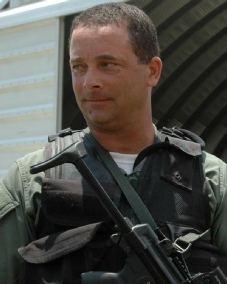
|
Howard Kritzer Smith III – Officer
Owasso Police Department
Howard K. Smith III was born in Spokane, Washington to Howard K. Smith II and Grace Marie (Higdon) Kirby on May 11, 1969. Howard K. Smith III was raised and educated in Meeker, Oklahoma and graduated from the Meeker High School in 1987. Howard Smith III went on to college at St. Gregory’s University in Shawnee and Northwestern State University in Tahlequah. Howard Smith III joined the Owasso Police Department in 1995. Howard Smith III and Susan Cathleen Daniels were married in Las Vegas, Nevada on October 1, 1996.
Howard Smith III served with the Owasso Police Department for twenty-six years. During his time as an Owasso Police Officer Howard served on the Honor Guard and as Assistant S.W.A.T. Commander.
Officer Howard Smith III, 52, contracted the Covid virus, was hospitalized and died from complications from the virus on Monday, September 27, 2021.
Howard K. Smith III was survived by his wife Sue, daughters Tori, Shauna and husband Jay Bellator, April Benjamin, and Angie Parker.
Officer Howard K. Smith III is buried at Calvary Cemetery, Shawnee, Pottawatomie County, Oklahoma.
OLEM – 10S-3-18 NLEOM – 45W33
July 29, 2022
|
|
|
|
|
|
Jeff Smith – Deputy U.S. Marshal
U.S. Marshal Service
Initial newspaper articles reporting on Jeff Smith’s death indicated he was a Deputy U.S. Marshal shot and killed while making an arrest. Later reports state that he was in fact not a Deputy U.S. Marshal and he was the one being arrested when he was shot and killed.
Jeff Smith had been “arrested” on Wednesday, February 15, 1888, for turning his horse into another man’s cornfield by Lafayette Teel, Jason Stelly, Joseph Beasley, and John Smith, who had no law enforcement authority. Jeff Smith was quickly released on advice of Deputy U.S. Marshal Connelly, who happened to be in the area. The four men later claimed that after releasing Jeff Smith they discovered that Jeff Smith had stolen some corn and they planned to “arrest” him and have him brought to Fort Smith for trial.
About daylight the morning of Friday, February 17th the four men, with John Smith acting as leader, went to Jeff Smith’s house, near Maysville, in the Flint District of the Cherokee Nation. While the others concealed themselves Lafayette Teel approached the house calling for Jeff Smith to come out. Jeff Smith came out and exchanged harsh words with Lafayette Teel during which John Smith came from his cover and shot at Jeff Smith, and then a general shooting commenced. Jeff Smith was shot in the forehead and John Smith was shot through the bowels, both falling dead near each other.
Jeff Smith’s wife and a man who was staying the night witnessed the shooting. The remaining three men were arrested for killing Jeff Smith. Joseph Beasley died soon after being placed in jail.
The end of October that year Lafayette Teel and Jason Stelly were tried and convicted of manslaughter in the death of Jeff Smith.
OLEM – 5N-3-5
June 15, 2022
|
|
|
|
|
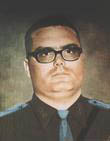
|
Larry Bruce Smith - State Trooper
Oklahoma Highway Patrol
Shortly before midnight on Friday, January 29, 1971, a burglary in progress was broadcast to officers in the Tonkawa area of Kay County. State Trooper Larry Smith headed to the location of the call. Five miles east of Tonkawa on Highway 60, Trooper Larry Smith was involved in a collision with a car traveling in the opposite direction that made a left turn in front of Trooper Smith. The other driver, a seventeen-year-old teenager, was also killed in the accident. Both cars came to rest in a roadside ditch north of the highway. The Highway Patrol car rolled once, coming to rest on its top. Both drivers were pinned in the wreckage of their vehicles.
State Trooper Larry Bruce Smith was the seventh Oklahoma Highway Patrol Trooper to lose his life in performance of his sworn duties.
Trooper Larry Smith was survived by his wife Carolyn and two sons.
Larry Smith is buried in Okmulgee Cemetery, Okmulgee, Okmulgee County, Oklahoma.
OLEM – 1N-2-8 NLEOM – 47W15
January 29, 2022
|
|
|
|
|
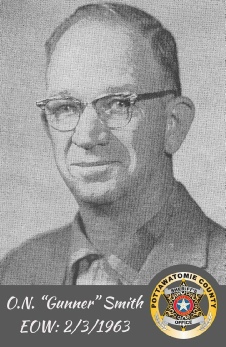
|
Odos Neal "Gunner" Smith - Deputy Sheriff
Pottawatomie County Sheriff’s Office
On the evening of Sunday, February 3, 1963, a McLoud Constable arrested Thomas Arthur Rittenhouse who had been hitchhiking carrying a 30-30 Winchester rifle. When the constable learned Arthur Rittenhouse was AWOL from an Air Force Base in Kansas, he arrested him. The constable contacted Deputy Sheriff Odos Smith at his home to assist him in transporting Arthur Rittenhouse to the Pottawatomie County Jail.
Shortly after 10 p.m. the constable was driving to Shawnee with Deputy Odos Smith and their prisoner, Arthur Rittenhouse, with his hands handcuffed in front of him riding in the back seat. Neither of the officers had not noticed a .25 caliber automatic pistol Arthur Rittenhouse was carrying in a shoulder holster. One mile east of Dale on Highway 270, Arthur Rittenhouse drew the weapon and shot Deputy Odos Smith four times in the chest, leg, and shoulders. The constable then wrecked the vehicle and Thomas Rittenhouse jumped out.
The wounded Deputy Smith got out of the wrecked police car and tried to pursue the fleeing suspect but collapsed in the roadway. A passing vehicle then fatally struck Deputy Smith laying in the highway and dragged his body thirty feet before stopping. Arthur Rittenhouse then returned to the scene and surrendered to the constable.
Deputy Sheriff Odos Smith was survived by his wife Allene and is buried in Fairview Cemetery, Shawnee, Pottawatomie County, Oklahoma.
OLEM – 7N-5-12 NLEOM – 48E5
February 2, 2021
|
|
|
|
|
|
Riley H. Smith - Deputy Sheriff
Seminole County Sheriff’s Office
Riley H. Smith was born in Arkansas in November 1883 to Mr. and Mrs. Willis T. Smith. In 1908 Riley Smith moved to Oklahoma and settled in Seminole, becoming a Seminole County Deputy Sheriff.
On Saturday, June 10, 1911, Deputy Sheriff Riley Smith went to Koekuk Falls, seven miles southeast of Prague, attempting to locate a fugitive. Unable to locate the fugitive, Deputy Sheriff Smith started on his way back to Seminole. About 6 p.m. Deputy Sheriff Smith stopped at a picnic and ball game two miles south of Keokuk Falls and three miles northeast of Little. Someone pointed out a black man and informed Deputy Smith that the man had illegal whiskey in his possession. As Deputy Smith approached the man, Lochie Carolina, the man made a move like he was going for a gun. Deputy Sheriff Riley Smith drew his gun and shot Lochie Carolina, killing him. The dead man’s brother, Prince Carolina, then grabbed Deputy Sheriff Smith as another man, Everett Lincoln, shot Deputy Sheriff Smith in the back killing him.
The two men then ran off.
Deputy Sheriff Riley H. Smith was survived by his wife Edith (Oakley) and two daughters, Lucille, 4, and Opal, 1.
Riley Smith is buried in Maple Grove Cemetery, Seminole, Seminole County, Oklahoma.
Prince Carolina was arrested in Jackson, Mississippi in September of 1911. Everett Lincoln was never located or prosecuted for the murder of Deputy Sheriff Riley Smith.
OLEM – 8S-1-14 NLEOM –
|
|
|
|
|
|
Rumsey Smith - Officer
Choctaw Nation Lighthorse
Rumsey Smith was a full blood Creek Indian who served as a Lighthorse for the Choctaw Nation in the Eufaula District from November 1895 until his death the following March.
In early March of 1896, Lighthorse Officer Rumsey Smith was serving court papers near Osochee Town (near Dewar) when he was shot and killed by Herman Barnett whom he was attempting to arrest.
Officer Rumsey Smith was survived by his wife and an adopted son named Jesse McDermott.
The burial site of Lighthorse Officer Rumsey Smith is unknown.
Herman Barnett was arrested later that night in Muskogee and taken to Eufaula where he was tried and convicted for the murder of Officer Rumsey Smith. Herman Barnett was sentenced to be shot June 19th for the murder of Officer Rumsey Smith and was executed in Eufaula on that date by the Choctaw Court.
OLEM – 10S-1-17 NLEOM –
March 15, 2022
|
|
|
|
|

|
Steve Roy Smith - State Trooper
Oklahoma Highway Patrol
About 7:30 p.m. on Sunday, April 25, 1999, the Delaware County Sheriff’s Office was notified that a woman had been shot at Ballard Cemetery north of Bernice. Officers found the woman’s dead body. It was that of Geraldine Davis who had been shot in the head. Shortly afterwards a pickup pulled into the Ballard Cemetery. The male driver got out and walked to a table in the cemetery. The man, Calton Davis, 52, was the husband of the dead woman and was armed with a .357 caliber magnum revolver.
Trooper Steve Smith was called to the cemetery to negotiate with the distraught man. Along with Sheriff Jim Earp, Trooper Steve Smith was able to talk Calton Davis into laying the revolver on the table. After over an hour of negotiations, at about 9:20 p.m., the officers felt they were not making any progress. They tried to distract Calton Davis and get to the revolver before Davis did. Unfortunately, Calton Davis was able to grab the revolver just as the two officers got to him. During the ensuing struggle Trooper Steve Smith was wounded in the neck and Sheriff Jim Earp was grazed in the arm before Calton Davis turned the gun on himself and committed suicide.
Trooper Steve Smith’s neck wound left him a quadriplegic, paralyzed below the neck and he was forced to take a medical retirement in December 2000.
Trooper Steve Smith, 43, died Thursday, February 9, 2006, from his injuries.
Trooper Steven Smith was survived by his son Blake and his daughter Stephanie and is buried in Memorial Park Cemetery, Bartlesville, Washington County, Oklahoma.
OLEM – 4S-3-23 NLEOM – 21E25
|
|
|
|
|

|
Thomas Calton "Tom" Smith - Deputy U.S. Marshal
U.S. Marshal Service
On Friday, November 4, 1892, Deputy Marshals Tom Smith, Dave Booker, and another deputy marshal named Tucker took a northbound train from Gainsville, Texas into the Chickasaw Nation of the Indian Territory to perform certain duties assigned to them. Sometime during the trip north, and when the train was nearing Thackerville, just inside Indian Territory, the deputies had gone into the “Jim Crow” passenger car normally reserved for blacks. One of the blacks took offense and asked what whites were doing in their car. Deputy Smith replied that whites could go where they wanted and got up to leave the car. The black man pulled a pistol and shot Deputy Smith through the heart, killing him instantly.
Deputies Booker and Tucker both pulled their weapons and killed the black man. The body of Deputy Smith was returned to his home in Taylor, Texas.
Deputy Thomas Smith was survived by his wife, five sons and a daughter and is buried in Taylor City Cemetery, Taylor, Williamson County, Texas.
Of their five sons, four would enter public service. William would become a Houston police officer. Tom C. Junior would become a Deputy Sheriff for Harris County, Texas. Megathan would be killed in the line of duty as a Houston fireman.
The eldest son, Frank S. Smith joined the Houston Police Department and then the Dallas Police Department. He later became an agent for the FBI and was credited with solving the Osage Hills murders in northeastern Oklahoma in the mid-1920’s. He was the only surviving lawman to escape the carnage of the Kansas City Massacre in 1933 unharmed. Frank Smith later served as the Chief of the Oklahoma City Police Department from 1939-1943. Deputy Marshal Thomas Calton Smith’s father, Thomas Jefferson Smith, was also a lawman.
OLEM – 3S-1-4 NLEOM – 35W7
November 4, 2022
|
|
|
|
|
|
Volley Milton Smith – Deputy Sheriff
Pushmataha County Sheriff’s Office
Volley Smith was born in Missouri November 7, 1879, to William and Flora Smith.
Volley Smith had been a Deputy Sheriff for Pushmataha County Sheriff H. B. Westerbrook for some time.
On Monday, November 15, 1920, Deputy Sheriff Volley Smith, 41, and another deputy sheriff were in the hills near Nashoba, northeast of Antlers, summonsing witness for an upcoming Grand Jury.
That Monday evening both deputy sheriffs were invited to spend the night at the cabin of Hugh Cockrum. Both deputy sheriffs accepted Hugh Cockrum’s invitation as it was getting late.
Later as the deputy sheriffs, Hugh Cockrum and a man named John Witt were having dinner in the cabin, an argument broke out between Hugh Cockrum and Deputy Sheriff Volley Smith.
It has never been determined what the argument was over. During the argument Hugh Cockrum grabbed a 30-30 Winchester rifle and shot Deputy Sheriff Volley Smith in the heart killing him instantly. Upon investigation Deputy Sheriff Smith’s body showed several bruises about his head and shoulders.
Deputy Sheriff Volley Smith’s body was transported back to Antlers for burial where he and his wife, Julia, lived. Newspaper reports indicate that Deputy Sheriff Volley Smith was buried in the Odd Fellows Cemetery in Antlers, but no record of his burial site has been found.
Hugh Cockrum and John Witt were charge with Deputy Sheriff Volley Smith’s murder.
On December 21, 1920, the Oklahoma Court of Criminal Appeals granted bail in the amount of twenty thousand dollars for Hugh Cockrum and ten thousand dollars for John Witt. Both men were able to post bond for their bails.
Hugh Cockrum also known as the “Kiamichi Wildcat” remained out on bail not only for the murder of Deputy Sheriff Volley Smith but also for another murder he was charged with.
About nine o’clock Monday night, May 5, 1925, Pushmataha County Deputy Sheriff Ben Bedford had driven to the east side of Max Brown’s store in Antlers to let his companion, Charley Land, out of the car. An intoxicated Hugh Cockrum, 60, saw Deputy Sheriff Bedford setting in the car and started toward him with a knife in his hand saying “well, here you are”. Hugh Cockrum had been heard to make several threats against Deputy Sheriff Bedford because of an arrest months earlier where Deputy Sheriff Bedford had to use force to subdue Cockrum.
As Hugh Cockrum approached Deputy Sheriff Bedford, Bedford shot Cockrum several times, killing him instantly.
Deputy Sheriff Ben Bedford was acquitted on May 30th of murdering Hugh Cockrum by a jury which deliberated only fifteen minutes to acquit Bedford as it was self-defense.
OLEM – NLEOM – rejected 2012
October 28, 2022
|
|
|
|
|
|
Warren N. Smith - City Marshal
City of Bokchito
On the evening of Tuesday, November 13, 1951, City Marshal Warren Smith, 51, was in Easter’s Café having dinner when Thomas Melvin Kernes, 40, walked in with a 12-guage shotgun. Kernes, carrying a grudge over a previous arrest by the City Marshal, fired one-time, striking City Marshal Smith with over fifty pellets in the lower right side and blowing away part of the city marshal’s holster. Thomas Kernes was arrested at his home seven miles northeast of Bokchito the next day. City Marshal Warren Smith died from his wounds five days later Sunday, November 18th.
City Marshal Warren Smith was survived by his wife Era and adult children.
Warren Smith is buried in Highland Cemetery, Durant, Bryan County, Oklahoma.
Thomas Kernes was convicted of the murder of City Marshal Warren Smith and sentenced to life in prison.
OLEM – 10N-2-5 NLEOM – 55W15
October 28, 2022
|
|
|
|
|

|
Kelley L. Smythe - Officer
Tulsa Police Department
Less than two weeks old, the Tulsa Police Department’s helicopter program suffered its first tragedy just before 10 p.m. on Friday, March 26, 1982. Pilot Chance Whiteman, 35, a five-year veteran of the police department, radioed that he and Officer Kelly Smythe, 25, also a five-year veteran of the department, would be in route to assist in a high-speed pursuit. That was the last transmission heard from the two Tulsa officers. A deputy sheriff found the helicopter crash site about 1:30 a.m. The helicopter had struck a tree and crashed a half-mile west of US Highway 75 just south of 66th Street North. Both officers died in the crash. The helicopter had been leased from the Oklahoma City Police Department and was found to have a current (FAA) air worthiness certificate, current annual inspection, and all periodic maintenance. Chance Whiteman was one of two helicopter pilots and had over one-thousand-five-hundred hours of flight time. Whiteman had flown helicopters for the Army in Vietnam and had survived being shot down twice. He still flew for the Oklahoma National Guard. Since it was a new program, the pilots were taking ground officers up to familiarize and orient them with the capabilities.
Officer Kelly Smythe was taking the place of the regular observer that night and was not assigned to the helicopter unit. Kelly Smythe was a life-long Tulsa resident and a graduate of Hale High School.
Kelly Smythe is buried in the Floral Haven Memorial Gardens Cemetery, Broken Arrow, Tulsa County, Oklahoma.
OLEM – 2N-1-22 NLEOM – 37W1
March 25, 2021
|
|
|
|
|
|
James D. Snider - Deputy Sheriff
Osage County Sheriff's Office
The evening of Sunday, February 13, 1921, Deputy Snider was called to the Midland Café in Avant in reference to a free for all fight. As Deputy Snider entered the café he was struck in the right temple by a heavy metal flashlight reportedly thrown by an intoxicated C. C. Moberly. Deputy Snider arrested Moberly and put him in the custody of some citizens outside the cafe. He and Constable George Bolt then were able to quite the other customers inside of the café. When they returned outside they found the men holding Moberly had let him go home. As the two officers walked to Moberly’s house Deputy Snider commented on the blow to his head stating it was “quite a jolt”. When the officers arrived at the house Deputy Snider waited out side the fence while Constable Bolt was sent in to bring Moberly out. When Bolt returned with Moberly he found the 45 year old deputy unconscious. He died about ten minutes later. It was determined that Deputy Snider had suffered a brain concussion from the blow by the flashlight. Moberly was charged with murder.
|
|
|
|
|
|
Samuel Jackson "Sam" Sorrels - Posse, Deputy U.S. Marshal
U.S. Marshal Service
Samuel Sorrels, 34, worked as a Posse for twenty-two-year-old Deputy United States Marshal Ralph Scargill. On Friday, January 2, 1903, both lawmen were riding on the Fort Smith and Western Railway train when they were told by a passenger about two suspicious men riding in one of the boxcars. The passenger thought one of the men was wanted. As the train slowed for a stop in Spiro, I.T., the two lawmen worked their way back to check the boxcars. Unknown to Deputy Marshal Scargill and Posse Sorrels one of the men in the boxcar was Sam Morley, a very dangerous man wanted for murder, assault, and escape in Oklahoma Territory.
As the train came to a stop, Deputy Marshal Scargill and Posse Sorrels jumped down from the passenger car and walked back toward the boxcars. As the lawmen approached the boxcars, they saw two men jump down from one of the cars. Deputy Marshal Scargill and Posse Sorrels identified themselves as lawmen and told the two men to throw up their hands. Sam Morley and the other suspect drew their handguns and started firing at the lawmen. Deputy Marshal Scargill and Posse Sorrels returned fire. The four men were only standing about four or five feet from each other. As they fired, they began backing away from each other. As they back away, Sam Morley was shot through the right side of his chest and fell to the ground. Posse Samuel Sorrels was then shot in the chest. Sorrels was able to fire two more shots before being killed by another shot to the chest. The second suspect had been wounded but kept firing, hitting Deputy Marshal Scargill in both legs causing him to slump to the ground. Scargill kept firing but his gun was now empty. The second man walked up to Deputy Marshal Scargill and took his gun, then walked over to Posse Sorrels and took his gun. The man then told the passengers that had been watching the shootout to back up or he would start killing them. He turned and walked into the woods toward the Poteau River and disappeared. A lengthy search was conducted but he eluded authorities.
Deputy U.S. Marshal Ralph Scargill slowly recovered from his gunshot wounds.
Posse Samuel Sorrels was survived by his wife Anna and their three young children Lena Anna, 14, Samuel Jefferson, 13, and Catherine Dollie, 8.
Samuel Sorrels is buried in the Oak Cemetery, Fort Smith, Sebastian County, Arkansas.
A $500 reward for Sam Morley was split between Deputy Marshal Scargill and Posse Sorrels’ widow Anna.
OLEM – 4S-1-3 NLEOM –
November 1, 2022
|
|
|
|
|
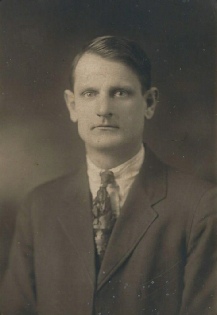
|
Jesse Henry Sosbee - Patrolman
Oklahoma City Police Department
About 2 a.m. on Friday, December 1, 1922, Officer Jesse Sosbee and his partner, Clarence O. Hurt, were driving through the 400 block of East Grand (now Sheridan) in Oklahoma City when they were shot at from ambush. Officer Jesse Sosbee, 37, was hit in the back. Officer Jesse Sosbee died the next day, December 2, 1922.
Officer Jesse Sosbee was survived by his wife Stella and is buried at Fairlawn Cemetery, Oklahoma City, Oklahoma County, Oklahoma.
Two black men, Tim Smith, and Herb Parker, were arrested, tried, and convicted for the murder of Officer Jesse Sosbee. Tim Smith was sentenced to five years in prison, and Herb Parker received seven years. They stated they just “wanted to kill an officer.” When taken from the city jail to the State Prison, both men were dressed as women to keep them from being recognized and lynched.
Clarence Hurt would later become Assistant Chief for the Oklahoma City Police Department, then join the FBI and become one of the three agents who shot John Dillinger in 1934. After his retirement from the FBI, Clarence Hurt was elected as Sheriff of Pittsburg County.
OLEM – 8S-3-8 NLEOM – 47W3
November 1, 2022
|
|
|
|
|
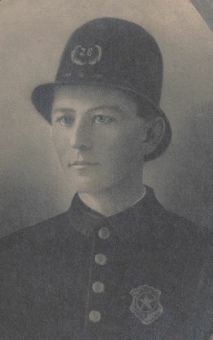
|
Joseph Soulek – Officer
Oklahoma City Police Department
Joseph Soulek was born on a farm near Munden, Kansas to Joseph and Rosalie Soulek on April 21, 1879. In 1894 he moved with his parents to a Cherokee Strip Land Run homestead near Perry, Oklahoma. The younger Joseph later became an Oklahoma City Police Officer.
Joseph Soulek was one of the oldest officers in longevity on the present Oklahoma City Police force in 1909. He had served all during the Hubatka administration and was one of the few to hold over during the present administration.
Officer Joseph Soulek, 29, reported for duty the morning of February 7, 1909, and walked his beat in the cold driving rain. Several hours later toward the end of his shift Officer Soulek began feeling ill. A few days later Officer Soulek was taken to St. Anthony Hospital. Shortly afterwards his illness turned into typhoid pneumonia and his condition continued to worsen. Officer Soulek was not allowed any visitors during his time in the hospital. Officer Soulek died in St. Anthony Hospital on March 20, 1909.
Officer Joseph Soulek’s body was taken to the train depot to be sent to his parents in Perry for burial. The entire Oklahoma City Police Force escorted Officer Soulek’s body to the train depot.
Officer Joseph Soulek is buried in Bohemian Catholic Cemetery, Perry, Noble County, Oklahoma and was survived by his parents.
OLEM – 10S-2-18 NLEOM –
April 26, 2022
|
|
|
|
|
|
Jerry S. Spann - Chief of Police
Shawnee Police Department
Jerry Spann served as a Deputy U.S. Marshal in Oklahoma Territory before statehood. After statehood, he was appointed as Assistant Chief of Police in Shawnee under Chief C.C. Hawk. Jerry Spann later succeeded C. C. Hawk as Chief of Police in Shawnee.
In 1918, Chief Jerry Spann had arrested a man and was taking him to jail when the man began fighting with Chief Spann. During the fight, Chief Spann suffered a serious head injury. The injury developed into cancer. Chief Spann sought treatment, unsuccessfully, as far away as the Mayo Clinic. Chief Jerry Spann died as a result of the cancer on Friday, March 26, 1920.
Jerry Spann is buried in Fairview Cemetery (Span), Shawnee, Pottawatomie County, Oklahoma.
OLEM – 8S-1-16 (Span) NLEOM –
March 25, 2023
|
|
|
|
|
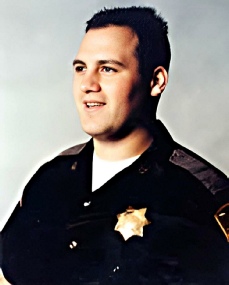
|
Constantine George Gus Spanos - Officer
Tulsa Police Department
At 1:48 a.m. the morning of Thursday, April 22, 1993, Officer Constantine “Gus” Spanos stopped a car on a routine traffic stop in the 5800 block of North Cincinnati Avenue. When a backup officer arrived minutes later, he found Officer “Gus” Spanos lying on the ground next to his patrol car, shot in the head. Officer Spanos was transported to the hospital where he died at 12:26 p.m. the next day, April 23rd. It was believed that the car Officer “Gus” Spanos stopped was filled with cocaine.
Officer Constantine “Gus” Spanos was survived by his wife Christie.
Constantine Spanos is buried in Floral Haven Memorial Gardens Cemetery, Broken Arrow, Tulsa County, Oklahoma.
Anthony Lyn Kimbrough was arrested a few days later. Anthony Kimbrough was tried, convicted of the murder of Officer “Gus” Spanos, and sentenced to life in prison without the possibility of parole.
OLEM – 2N-3-1 NLEOM – 47W19
April 21, 2021
|
|
|
|
|
|
James Collin “JC” Sparger – Traffic Officer
Oklahoma City Police Department
James Collin Sparger was born June 30, 1864, in Bonham, Fannin County, Texas. At the age of twenty-one James married nineteen-year-old Neddie Carter in Fannin County, Texas on June 20, 1885.
James Sparger was not a man to allow his age to deter him from seeking what may have been considered a young man’s pursuits in life. In 1918, at the age of fifty-four, James Sparger enlisted in the U.S. Army, but the war ended before he saw combat. In 1932 at the age of sixty-eight, James joined the Oklahoma City Police Department and served as a Traffic Officer stationed at the intersection of NW 23rd and Walker.
On the evening of Friday, October 12, 1934, Officer James Sparger, 70, was off duty and taking a walk near his home at 429 NW 27th Street. At the intersection of NW 24th and Classen Boulevard, James Sparger stepped into the street apparently without looking for oncoming traffic and was struck by a car. The car was driven by fifteen-year-old Bruce Cox who was questioned and released. Officer Sparger was transported to the hospital where he died the next morning, Saturday, October 13th.
James Sparger lived in Oklahoma City for the past eighteen years. In 1930 James and his wife Neddie were living with their son Carter in Oklahoma City.
James Sparger was survived by two daughters and a son, Carter. James Sparger is buried in Willow Wild Cemetery, Bonham, Fannin County, Texas.
OLEM – 7N-1-19
November 19. 2022
|
|
|
|
|
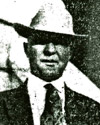
|
Homer Ross Spaulding - Captain
Okmulgee Police Department
Early on the morning of Sunday, January 8, 1922, Captain Homer Spaulding, Detective Mark Larimore, and Patrolman M.E. Spence decided to pile into a single car and tour the central section of the city after receiving a hot tip that a robbery of the local jewelry store was planned.
About 3:10 a.m. the three lawmen spotted a large Buick touring sedan parked along the roadside. Two men were working on the engine of the Buick while several others were sitting inside. Captain Homer Spaulding, who was driving, pulled the police cruiser in front of the Buick with the headlights pointing directly towards the Buick. The lawmen stepped from their cruiser and approached the car. Captain Spaulding asked if they needed any assistance. One of the men leaning over the engine stated they could use a flashlight. Officer Larimore eased toward the back of the suspect car to get a look at the occupants. Noticing several shotguns and rifles lying on the back seat he commented to his fellow officers to “be careful boys, they are armed.” At that moment one of the men working on the engine pulled a gun and shot Captain Homer Spaulding in the thigh. Shots were fired back and forth with Detective Larimore being struck in the leg. Larimore shot one of the men in the arm. Both Larimore and Patrolman Spence shot the man in the head that had shot Spaulding. Detective Larimore also notice a man inside the car trying to load a shotgun and fired several rounds in the car wounding the suspect. At this point, two other suspects bolted from the car running as fast as they could. Larimore and Spence both shot in the direction of the fleeing men. A blood trail was later found indicating that at least one of the fleeing assailants had been hit.
At the end of the mayhem, one suspect was dead, two were wounded and two had fled on foot, of which at least one was also wounded.
Captain Spaulding was transported to the Okmulgee Hospital for treatment; he was bleeding badly from his leg wound. Larimore rushed home to show his wife the bullet wound in his leg and she insisted he go to the hospital for treatment as well. After a night in the hospital, Detective Larimore was released.
When officers searched the crime scene they found various weapons, a bottle of nitroglycerin and an assortment of burglary tools. The following day, Tulsa authorities officially identified the dead bandit as Jimmy Sexton, a small-time hood from Tulsa’s Central Park neighborhood. Meanwhile, Captain Spaulding was rushed to surgery and was listed in stable condition. A few days later, the hospital put out the word that Spaulding was bleeding internally and had taken a turn for the worse. Spaulding’s wife and son were sent for. The doctors decided to perform another emergency operation. Spaulding reportedly whispered to Chief Farr; he didn’t think he would make it through the night. Spaulding died on the operating table. Captain Spaulding was given a hero’s funeral with over five hundred people in attendance.
Homer Spaulding was survived by his wife Edith and adult son George and is buried in Greenhill Cemetery, Muskogee, Muskogee County, Oklahoma.
Four men were arrested for the murder of Captain Spaulding. Ed Lansing was convicted of first-degree murder and given the death penalty. On appeal the sentence was reduced to life in prison. Frank Hadley tried to claim self-defense, but the jury wasn’t convinced. He was sentenced to twenty-five years in prison. His lawyer promptly appealed, and the Oklahoma Court of Appeals overturned the verdict, and he was set free. Volney Davis and “Doc” Barker were convicted of the murder of the St. John’s night watchman and a Tulsa County jury sentenced both to life in prison. Davis was given a leave of absence from the penitentiary in 1932. He rejoined his old partner “Doc” Barker, who had since been released from prison, in time to assist him and his gang with the Bremer kidnapping job and several bank robberies. It was suspected but never proven that Volney Davis had been granted his leave due to a payoff arranged by the Barker Gang to a state official. Volney Davis was captured in 1935 by the FBI and given life imprisonment at Alcatraz Federal Penitentiary. Volney Davis died in Oregon in 1978.
OLEM – 8S-2-17 NLEOM – 16E23
|
|
|
|
|
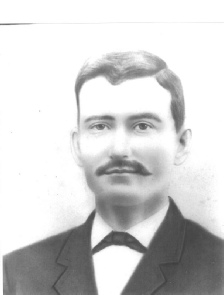
|
Richard “Dick” Speed - Deputy U.S. Marshal
U.S. Marshal Service
Richard Speed became a constable in Chautauqua County Kansas, on the northern border of Indian Territory and held that position for four years. He then became a Deputy U.S. Marshal in the Oklahoma Territory and was one of three officers fatally wounded during the battle of Ingalls with the Dalton/Doolin gang on September 1, 1893.
In late August 1893, Bill Dalton, Bill Doolin, George “Bitter Creek” Newcomb, Red Buck Weightman, Dynamite Dick Clifton, Tulsa Jack Blake and Roy “Arkansas Tom” Daugherty, members of the Dalton/Doolin gang were reported to be in Ingalls, a small town ten miles east of Stillwater in Payne County, Oklahoma Territory.
On Friday, September 1, 1893, two covered wagons entered Ingalls. Concealed inside them was the ominous number of thirteen Deputy U.S. Marshals: Thomas J. Hueston, Lafayette Shadley, Dick Speed, Ham Hueston (Tom’s brother), Henry Keller, George Cox, M. A. Iauson, H. A. Thompson, John Hixson, Jim Masterson (Bat’s brother), Doc Roberts, Ike Steel and Steve Burke.
Seeing Bitter Creek Newcomb leading his horse down the street, Deputy Dick Speed opened the battle by wounding Newcomb. George “Bitter Creek” Newcomb drew up his Winchester just as Deputy Marshal Speed threw up his rifle and fired. Speed’s bullet shattered the magazine on Newcomb’s Winchester driving part of it into his leg. “Bitter Creek’s” first shot went wild, and he was unable to get off a second shot with the damaged gun. Deputy Speed stepped up and took aim for a final shot at “Bitter Creek.” In the meantime, Roy Daughtery also known as “Arkansas Tom” heard the shots, ran to his second-floor OK Hotel room window in time to see Deputy Marshal Dick Speed take aim at Newcomb. “Arkansas Tom” quickly shot Deputy Marshal Speed, hitting him first in the shoulder and then killing him instantly with a second shot. Roy Daugherty then shot Deputy Marshal Thomas Hueston twice, once in the left side and once in the bowels.
Deputy Marshal Lafe Shadley was shot three times while trying to climb through a fence by either Roy Daugherty or Bill Dalton or both. Roy Daugherty was arrested that day, but the rest of the gang escaped. Deputy Marshal Thomas Hueston died the next day on September 2nd. Deputy Marshal Lafayette Shadley, 49, died the day after that on September 3rd.
Deputy Marshal Richard “Dick” Speed was survived by his wife, Rachel, and three sons, Charles, 5, Richard, 4, and William, 1, and is buried in the Perkins Cemetery, Perkins, Payne County, Oklahoma.
OLEM – 5N-3-2 NLEOM – 12E8
July 10, 2022
|
|
|
|
|
|
Floyd James Spencer - City Marshal
Boynton
Floyd Spencer was one of sixteen children, was 49 years old and had been City Marshal at Boynton in Muskogee County for two years.
About 2:30 p.m. Saturday, January 21, 1950, Marshal Spencer was confronted by local grocer Floyd Rutherford in front of Rutherford’s store. Rutherford asked the marshal why he had been following him? Marshal Spencer stated he had not been following him and that since Rutherford was drunk, he needed to give him his gun which was in his hand. After telling Rutherford several more times to give him his gun Rutherford raised his gun as Marshal Spencer drew his. Both men began firing at the same time. Marshal Spencer was hit twice in the stomach while Rutherford was struck in the thigh and arm. Both men were taken to the hospital where Marshal Floyd Spencer died early the next morning at 2:35 a.m.
Marshal Floyd Spencer was survived by his wife of twenty-seven years, Ada plus two daughters and five sons and is buried in Eureka Cemetery, Hulbert, Cherokee County, Oklahoma.
Floyd Rutherford was charged with City Marshal Floyd Spencer’s murder. After being released from the hospital Floyd Rutherford was tried, found guilty and sentenced to life in prison. The Oklahoma Criminal Court of Appeals upheld the conviction and sentence in May 1952.
OLEM – 9S-3-4 NLEOM – 11E28
November 12, 2022
|
|
|
|
|
|
William “Bill” Spivey - Posse, Deputy U.S. Marshal
U.S. Marshal Service August 6, 1874
William Spivey worked as a Posse for Deputy U.S. Marshal William Erwin in the Indian Territory. Deputy Marshal Erwin worked under Western District of Arkansas U. S. Marshal John Sarber. Part of their district involved the southern part of the Choctaw and Chickasaw Nations that bordered Texas.
James Moore, a twenty-eight-year-old native of Johnson County, Tennessee, and James C. Hunton had stolen several horses from a man named Cox in Washington County, Texas. Civilians had tracked the horse thieves from Washington County north into the Indian Territory. After crossing the Red River, they notified Deputy Marshal William Erwin of the chase and requested he assist. Deputy Marshals William Erwin and Posse William Spivey joined the hunt for the horse thieves, searching the area just north of the Red River.
On Thursday, August 6, 1874, the two law men found their prey and attempted an arrest. Both James Moore and James Hunton resisted arrest and both sides commenced firing. During the shootout Posse William Spivey was shot in the head, dying instantly and Deputy Marshal William Ervin was also wounded, although not seriously. Both James Moore and James Hunton were able to make their escape. Once notified a large search was begun for the killers.
Posse William Spivey was survived by his wife Francis Holt and four-year-old daughter, Mary Kathrine.
The burial site of Deputy U.S. Marshal Posse William Spivey is unknown.
Deputy U.S. Marshal Kidder Kidd and his posse, L.P. Isbell, and R.T. Brewer, along with guard Nelson Foreman tracked James Moore to Caddo Creek in the Chickasaw Nation, arresting him on September 15th. Next, they traveled to Fayetteville, Arkansas where they located James Hunton and placed him under arrest. Both prisoners were then taken to Fort Smith and confined in the federal jail to await trial. On February 9, 1875, while awaiting trial, James Hunton was able to escape. In April the U.S. Marshal was notified that citizens had shot and killed James Hunton during a chase, after he had stolen a horse.
Judge Isaac C. Parker held trial for James Moore on May 25, 1875. The jury returned with a verdict of guilty of first-degree murder and the judge quickly sentenced James Moore to be hanged. On September 3, 1875, the sentence was carried out with James Moore being hung on the courthouse scaffold.
OLEM – 5N-1-5 NLEOM – 19E3
Updated August 6, 2023
|
|
|
|
|

|
Jerome Thurman Spybuck - Sergeant
Tulsa Police Department
Shortly after noon on Friday, April 2, 1971, nine local and federal officers conducted a drug raid on the residence of Truman Trowbridge. One of those officers was Tulsa Police Sergeant Jerome Spybuck. Although officers had reason to suspect weapons were in the Trowbridge house, the basis for ATFU agents joining in the raid, none of the nine officers carried shotguns. The residents refused to open the door and agents proceeded to break it down. As they entered, Truman Trowbridge opened fire on the officers then ran out the back door. As Trowbridge was running toward the garage, he turned and saw Sergeant Jerome Spybuck coming at him from the front of the lot. Truman Trowbridge began firing at Sergeant Spybuck. Sergeant Spybuck returned fire wounding Trowbridge before falling to the ground. Truman Trowbridge’s wife, Glenda Marlene, and Donald Odell Birdwell were both arrested as material witnesses. A large quantity of drugs, stolen property and illegal blasting caps were seized in the raid.
Sergeant Jerome Spybuck and Truman Trowbridge were taken to St. Francis Hospital where Sergeant Spybuck died on the operating table about 2 p.m.
Sergeant Jerome Spybuck was survived by his wife Lula and their two daughters and is buried in Park Grove Cemetery, Broken Arrow, Tulsa County, Oklahoma.
Truman Trowbridge survived his wounds, was charged with Sergeant Spybuck’s murder, was convicted, and sent to prison for life. On July 13, 1989, Truman Trowbridge, 42, was stabbed to death by another inmate in the prison exercise yard.
OLEM – 1N-2-12 NLEOM – 52W8
April 3, 2022
|
|
|
|
|
|
Charles N. Stamper - Deputy Sheriff
Tulsa County Sheriff’s Office
On Sunday, October 9, 1910, in the village of Dawson, a small coal mining station north of Tulsa, a group of miners were having a dice game in a tent when a confrontation erupted. Some of the upset miners started shooting at each other. When the shooting had spilled over into the community sending citizens for cover, a messenger was sent to summon Deputy Sheriff Charles Stamper who lived in Dawson. Stamper’s neighbor, Jack Leighton, came to assist. As Deputy Sheriff Stamper dismounted and walked around behind his horse, a miner named Frank Henson fired his revolver, shooting Deputy Sheriff Charles Stamper in the face. When Deputy Stamper went to his knees, Frank Henson fired again. Returning fire, Deputy Sheriff Stamper was able to shoot Henson in the leg and thigh. Although mortally wounded, Deputy Sheriff Charles Stamper continued to fight back with citizens of Dawson assisting. Deputy Sheriff Stamper was able to ride his horse to his residence where his wife, Emma, sent for the doctor. When Sheriff Newblock arrived in Dawson, the citizens had apprehended four individuals; a fifth had fled. The Sheriff started in pursuit of the fifth suspect, catching up to him in Margo. Deputy Sheriff Charles Stamper died that day from his wounds after having surgery at the Tulsa Hospital.
Deputy Sheriff Charles Stamper, 23, was survived by his wife, Emma, and their three children ages 7, 3 and 3 months and is buried in Oaklawn Cemetery, Tulsa, Tulsa County, Oklahoma.
After deliberating for only twenty-two minutes, a jury found 22-years old, Frank Henson guilty of the murder of Deputy Sheriff Charles Stamper and sentenced Henson to hang. The death sentence was carried out in front of a crowd of approximately five hundred people on March 31, 1911. No one ever learned if the suspect’s true name was Frank Henson. He was tried, convicted, and hung as Frank Henson, but a letter he wrote, found after his death, was signed Amos Bell.
Deputy Sheriff Charles Stamper’s death led to the first, and last, legal hanging ever carried out by a Tulsa County Sheriff.
OLEM – 3S-2-5 NLEOM – 52E12
December 4, 2022
|
|
|
|
|
|
William Tener Starmer - Posseman, Deputy U.S. Marshal
U.S. Marshal Service
William T. Starmer was born March 6, 1856, in Missouri to Jacob T. and Elizabeth Safronia Blakely Starmer. William Starmer was 26 when he married Nancy Cathrine Boyer, 21, on September 21, 1882, in Daviess County, Missouri.
On the morning of Saturday, May 2, 1891, William Starmer, 35, was leading a posse chasing after two men who had stolen some horses. Little did Posse William Starmer know that the horse thieves he was pursuing were Bob and Emmett Dalton. The posse chased the two men into a canyon near Twin Mounds in eastern Payne County. As the posse dismounted the Daltons ambushed them. Pose William Starmer was shot and killed. Starmer’s body showed three bullet holes in his chest, all close enough that a man’s hand would cover all of them. When one of the other pose members saw the bullet wounds in William Starmer’s chest, even before the suspects could be identified, he is said to have remarked that only Bob Dalton could shoot like that. The Daltons escaped until they were killed during a bank robbery attempt in Coffeyville, Kansas, in October of 1892.
William Starmer was survived by his six-year-old daughter Gertrude and four-year-old son Claude. William Starmer’s wife Nancy had died in 1887 the same year Claude was born.
The exact burial site of William Starmer is unknown but is believed to be in Creekmore Cemetery, Altamont, Davies County, Missouri where his wife Nancy is buried.
OLEM – 5N-2-17 NLEOM –
May 2, 2022
|
|
|
|
|
|
Charles C. “Shoot” Starr - City Marshal
City of Braggs
When Mose Miller was released from prison a long-standing feud between the Miller and Starr families was rekindled. Mose Miller was described as “a mad killer” and “the most desperate and daring outlaw of Indian Territory” in newspaper accounts.
Charles Starr, 39, had been appointed as the City Marshal of Braggs. Mose Miller was killed September 30, 1916, in Vian. The next day, October 1st, a friend and accomplice of his, Oce Dazzler, also a known killer, heard of Mose Miller’s death and believed it was due to the feud with the Starrs. Oce Dazzler was out to get revenge. Later that evening Oce Dazzler entered a bar in Braggs and started causing a commotion. Soon City Marshal Charles Starr and Constable J. W. Marlow were summoned. As City Marshal Starr and Constable Marlow entered the bar, Oce Dazzler began firing. Marshal City Starr was hit three times and fell to the floor, dead. Constable Marlow was wounded, but able to return fire and shoot and kill Oce Dazzler.
City Marshal Charles Starr was survived by his wife of nineteen years, Georgia and six children, Pocahontas, 18, Juanita Ruth, 15, Jack Raymond, 11, Inez Corrine, 8, Cherry Catherine, 5, and Charles Thomas, 3.
Charles C. Starr is buried in South Bethel Cemetery, Braggs, Muskogee County, Oklahoma.
OLEM – 10N-1-8 NLEOM –
October 12, 2022
.
|
|
|
|
|
|
George Colbert “Carl” Starr - Deputy Sheriff
Rogers County Sheriff’s Office
On Friday, September 20, 1912, Rogers County Sheriff W.E. Sanders and Deputy Starr were checking for bootleggers around the area just north of Collinsville. About 6:40 P.M. they spotted a wagon with three men in it. They stopped the wagon. Sanders went to the front of the wagon and Starr went to the rear. After being ordered to get down off the wagon, one of the bootleggers, as he was getting down, pulled a gun and fired at Starr. Deputy Starr immediately went down, fatally wounded through the heart. Sanders shifted his focus from the man he was holding at gunpoint to the man who was shooting at Starr. Both men began shooting and Sanders was wounded twice in the arm. Two of the three men on the wagon were able to escape, but Sanders was able to hold one man in custody. Sanders returned to Collinsville with the body of Starr and his prisoner, John Ettor. A posse was formed and they pursued the other two men, who were identified as Jack Triplett and the driver, named Guinn. They were captured the following day. Triplett and Ettor were found guilty and given life sentences.
|
|
|
�
|
|
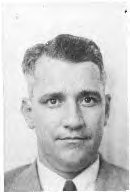
|
Gerald Martin “Jerry” St. Clair - Patrolman
Tulsa Police Department
On Friday, August 30, 1946, Officer Gerald St. Clair, and Officer Elmer Strotman, were in pursuit of a grocery store robber. Shots were being fired back and forth from one car to the other. The officers were following about twenty-five feet behind the fleeing suspect. The fugitive, without looking back, reached over his shoulder, and fired at the pursuing patrol car. The bullet penetrated the windshield and hit Officer Gerald St. Clair in the forehead. Officer Elmer Strotman managed to guide the patrol car to a safe stop. Officer Harold Harding was also wounded in the leg as he was riding his police motorcycle in the pursuit. Officer Harding recovered from his wounds, but Officer Gerald St. Clair died on September 2, 1946.
Gerald St. Clair was survived by his wife Leona and nine-year-old son Charles and is buried in Park Grove Cemetery, Broken Arrow, Tulsa County, Oklahoma.
A suspect, identified as Victor Lloyd Everhart, was arrested first but escaped. Everhart kidnapped a cab driver and his wife and forced them to drive to Chouteau. The cab was stopped by the Oklahoma Highway Patrol. During the ensuing gun battle, the cab driver was wounded, and Victor Everhart was killed.
Carl Austin DeWolf was arrested about two months later in possession of the .45 caliber gun that killed Officer Gerald St. Clair and was charged with Officer Gerald St. Clair’s murder. DeWolf claimed that he got the gun from Victor Everhart. Carl DeWolf claimed his innocence until November 17, 1953, the day he was executed for killing Officer Gerald St. Clair.
Officer Elmer Strotman retired from the Tulsa Police Department in 1956 after serving for twenty-four years. In 1992 he was honored in the first Oklahoma Law Enforcement Appreciation Day parade in Oklahoma City as the oldest retired law enforcement officer in Oklahoma. Elmer Strotman died in a nursing home in Tulsa on July 16, 1996, at the age of 96.
OLEM – 7N-2-24 NLEOM – 46W9
September 1, 2021
|
|
|
|
|
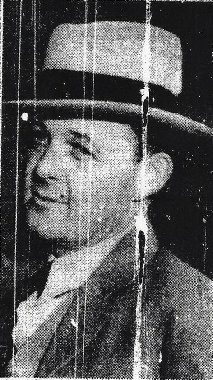
|
George Watson Stewart – Former Tulsa Officer
Tulsa Police Department
George Stewart was born in Missouri on April 30, 1899, to John Robert and Sarah Elnora (Herald) Stewart. As a teenager George Stewart served in World War I. George Stewart served as a Deputy Sheriff for Mayes County and Tulsa County before becoming a Tulsa Police Officer in early 1933. In November 1933 Stewart was promoted from Detective to Captain of Detectives.
By late 1935 George Stewart had left the Tulsa Police Department and was working as a private investigator.
Shortly before midnight on Wednesday, December 4, 1935, George Stewart, and federal revenue agent Louis Pappan, also a former Tulsa Police Officer, went into the Sheridan Club at 51st Street and Sheridan Road in Tulsa. At the time George Stewart had no law enforcement authority. The two men were attacked by club employees George L. “Hickory” McCullough and Tyree Parks. Both George Stewart and Agent Louis Pappan were pistol whipped as the fight moved outside. Agent Pappan sustained a badly fractured skull from the beating. Both George Stewart and Louis Pappan were then shot several times each killing them as they laid on the sidewalk. Autopsies would later show George Stewart was shot twice in his left side and once in the head and that Agent Pappan was shot been shot five times in the back of the head while he laid face down on the floor.
George Stewart was survived by his wife Mildred and one child and is buried in Rose Hill Memorial Park, Tulsa, Tulsa County, Oklahoma.
George L. “Hickory” McCullough and Tyree Parks were charged with both murders.
OLEM – 8S-5-21
May 2, 2022
|
|
|
|
|
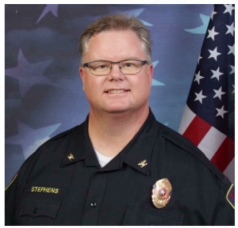
|
Richard Leslie Stephens – Chief of Police
Union City Police Department
Richard L. Stephens was born December 21, 1967, to Charles “Roy” and Dixie Stephens.
Richard dedicated his life to serve others and his community through personal interactions as well as commitment in his job as both an EMT/paramedic and a Law Enforcement Officer spanning over thirty years.
Chief of Police Richard Stephens and his wife Tanya contracted the Covid virus just before Christmas 2021 and were hospitalized at Integris Canadian Valley Hospital in Yukon.
On December 26, 2021, Richard Stephens was moved to ICU and placed on a ventilator.
Tanya remained on oxygen and continued to show improvement. Tanya Stephens was released from the hospital on January 2, 2022.
About January 20, 2022, Chief Richard Stephens was transferred to Select Specialty Hospital in Oklahoma City and placed in their ICU. Richard showed some improvement by February 1, 2022, as he was taken off sedatives and began some physical therapy.
The morning of Friday, February 4, 2022, Chief Richard Stephens died from complications from the virus.
Chief Richard Stephens was survived by Tanya, his wife of twenty-two years, his son Andrew and his wife Tiffany, son Jacob “Jake”, and daughter Mitchel (Rachel).
Chief Richard Stephens is buried at Mustang Cemetery, Mustang, Canadian County, Oklahoma.
OLEM – 12N-1-2 NLEOM – 57E33
April 19, 2023
|
|
|
|
|

|
William Lewis Stewart Jr. - Lake Ranger
Oklahoma City Police Department
William Stewart, Jr was born February 17, 1949, to William Lewis, Sr. and Doris Marie (Carroll) Stewart in Wichita, Sedgwick County, Kansas.
On the evening of Friday, May 17, 1974, on a tip from a caller shortly after 5 p.m., police officers were dispatched to the Lake Hefner area in search of Lake Ranger William Stewart. The caller stated he had seen an empty lake ranger’s boat adrift and empty. The responding police officers found the boat grounded on the northeastern shore with the engine still running. Ranger William Stewart had radioed in just before 5 p.m. but was now missing. Winds were gusting over forty miles per hour and waves were over a foot high at the time. Officers located the missing ranger’s gun, gun belt, boots, and hat on an island about half a mile away from the beached boat. A force of twenty Lake Rangers, Oklahoma City Police Officers, and firemen searched all night long, aided by two National Guard helicopters.
Fire department divers began dragging the lake and, about 11 a.m. the next day, and found the body of Ranger William Stewart about fifty yards north of the island. Investigating officers hypothesized that Ranger Stewart had been making a routine check of the island when the winds set his boat adrift. The boat’s rope was still attached where he had tied it. Lake Ranger William Stewart apparently stripped off his boots, hat, and gun belt, tried to swim out and retrieve the boat but drowned in the churning waters.
William Stewart, 25, had been a lake ranger for about one year, was survived by his wife Mary and a son.
William Stewart, Jr. is buried in Arlington Memory Gardens, Oklahoma City, Oklahoma County, Oklahoma.
OLEM – 2N-3-7 NLEOM – 51W3
|
|
|
|
|

|
William Ross "Bill" Stewart, Jr. - Agent
Oklahoma Bureau of Narcotics and Dangerous Drugs Control
About 10 p.m. on the evening of Wednesday, May 8, 1985, Agent William Stewart, along with OBNDD Agent Jim Dempewolf and Woodward Police Officer Mark Chumley, was conducting an undercover drug investigation in Woodward. The officers were finishing an undercover purchase of amphetamines from Marshall Ellis outside of a Long John Silver’s Restaurant. Marshall Ellis opened fire on the three officers with a 12-guage shotgun when they identified themselves as police officers. Agent William Stewart was killed, and Officer Chumley was wounded. Marshall Ellis’s girlfriend, who was sitting in the car with him at the time, received a minor wound from the officers’ return fire. Within a couple of hours Marshall Ellis was arrested a few blocks from the crime scene. Ellis was charged with murder, two counts of Shooting with Intent to Kill, and Distributing a Controlled Dangerous Substance.
William Stewart had previously been a Deputy Sheriff in Mendocino County, California where he earned the reputation as “the most dangerous narc in America.” In 1985 William Stewart was a three-and-a-half-year veteran of the OBNDD and became the head of the Enid office of the OBNDD.
Agent William Stewart was survived by his wife and three daughters and is buried in Oak Mound Cemetery, Healdsburg, Sonoma County, California.
OLEM – 2N-2-9 NLEOM – 51W3
December 4, 2022
|
|
|
|
|
|
Ed Stockton – Deputy U.S. Marshal
U.S. Marshal Service
Mr. O. K. Bivins’ notes indicate only that Deputy U.S. Marshal Ed Stockton was killed in Purcell in 1892. This Deputy Marshal is not included on the U.S. Marshal Service list but is on the Fort Smith memorial for the year 1892. An article in the Oklahoma Orbit of November 22, 1959, states that Deputy Marshal Stockton was killed in Purcell by a named Cornelius Walker who was later killed by Deputy U.S. Marshal John Swain while attempting to arrest Walker. No contemporary account of this Deputy U.S. Marshal’s death has been found.
OLEM – 5N-3-4
July 10, 2022
|
|
|
|
|
|
E.dgar Allen. “Ed” Stokley - Deputy U.S. Marshal
U.S. Marshal Service
Deputy Marshal “Ed” Stokley was twenty-seven years old and lived with his father in Marietta. “Ed’ Stokley had worked for Deputy U.S. Marshal Heck Thomas for two years as a posse receiving some of the best training he could have received. In June 1887, partially due to the recommendation of Thomas, John Carroll, the U.S. Marshal for the Western District of Arkansas, had appointed “Ed” Stokley a Deputy U.S. Marshal. Everything appeared to be going well with Stokley’s life. He had a full appointment as a Deputy Marshal and was scheduled to be married to Josie Peterman of Gainesville, Texas, on January 25, 1888.
On December 2, 1887, Deputy U.S. Marshals Heck Thomas and Ed Stokley had approximately forty prisoners in their charge and were transporting them to Fort Smith when they received information that Will Towerly had just arrived at his father’s home near Atoka. Every Deputy U.S. Marshal in the Indian Territory had been put on alert to watch for and apprehend Will Towerly, who was charged with the murder of Deputy U.S. Marshal Frank Dalton. Both Thomas and Stokley carried posse and guards with them and after talking the situation over, decided that Deputy Marshal Heck Thomas and some of their men would remain in camp with the prisoners while Deputy Marshal “Ed” Stokley, along with William Moody, James Wallace and James McAlester, would check out the Towerly house.
The following morning around 7:00 a.m., the lawmen surrounded the Towerly home with James Wallace and James McAlester covering the rear of the house and Deputy Marshal “Ed” Stokley and William Moody at the front. Will Towerly must have seen the lawmen approach, for he suddenly appeared at the front door, ran out and opened fire. Will Towerly missed with his first shots and Deputies “Ed” Stokley and William Moody both opened fire on Towerly. Will Towerly was hit in the right shoulder and the leg knocking him to the ground. Deputy Marshal “Ed” Stokley was running toward the downed man when Will Towerly rose up and fired two rounds with his left hand, both striking Deputy Marshal “Ed” Stokley, once in the chest and once in the groin. Deputy Marshal Stokley dropped and died within minutes. William Moody continued to fire at Will Towerly as his parents and sister pushed Moody into the house. William Moody pushed them off and fired through a window at Will Towerly, striking him several times. Will Towerly died from the eight bullets that pierced his body about twelve hours later.
Deputy Marshal “Ed” Stokley’s body was returned to his father’s home at Marietta and was buried in the Fairview Cemetery, Gainesville, Cooke County, Texas.
OLEM – 5N-2-2 NLEOM – 3E6
December 3, 2021
|
|
|
|
|
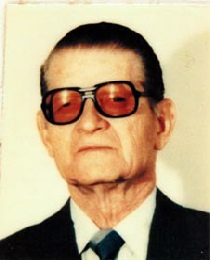
|
Chester W. Stone - Agent
Oklahoma State Bureau of Investigation
Chester W. Stone was a native of Golden City, Missouri. Stone served over twenty-five years as a State Examiner and Inspector for the School Land Audit Department before joining the Oklahoma State Bureau of Investigation (O.S.B.I.). Agent Chester Stone was widely recognized as one of the most knowledgeable oil field crime investigators in the state.
On Wednesday, March 11, 1981, Agent Chester Stone responded to a call for assistance from Kingfisher County Sheriff’s Office. Agent Chester Stone, after locating and arresting the suspect the deputy sheriffs were looking for, suffered a fatal heart attack. Before collapsing, however, Agent Chester Stone was able to handcuff the suspect to the steering wheel of his state car to prevent the suspect’s escape. Kingfisher County Deputy Sheriff Coy Barker transported the 66-year-old O.S.B.I. agent to El Reno hospital where Agent Chester Stone died at 2:30 p.m.
Agent Chester Stone was survived by his wife Nellie and is buried in Rose Hill Burial Park, Oklahoma City, Oklahoma County, Oklahoma.
OLEM – 2N-1-15 NLEOM – 55E5
March 5, 2021
|
|
|
|
|
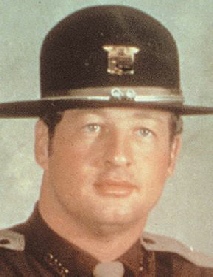
|
Kenneth Dean Strang - Second Lieutenant
Oklahoma Highway Patrol
Kenneth Strang was born February 13, 1942, in Carnegie, Oklahoma.
When Kenneth Strang joined the Oklahoma Highway Patrol (OHP) in 1966, he became a second-generation Trooper following in his father, Wallace “Wally” Strang’s footsteps. Wallace graduated from the 8th Highway Patrol Academy and was a former Okfuskee County Sheriff.
Shortly before 6:00 a.m. on Saturday, March 1, 1980, Second Lieutenant Kenneth Strang, Field Supervisor for Troop B, was going home after working a ten-hour shift, traveling north of Okmulgee on State Highway 75. On most other nights, Lieutenant Strang would have been headed home by 2:00 a.m. But winter storms often meant long hours and extra duty for OHP troop supervisors such as Second Lieutenant Kenneth Strang. Since 7:00 p.m. Friday evening, Lieutenant Strang had been working a deluge of traffic accidents, some minor, some more serious. At 5:55 a.m. that Saturday morning, Lieutenant Kenneth Strang radioed Tulsa Highway Patrol headquarters, as he had hundreds of times in his career, to run a check on an abandoned vehicle he passed as he headed home. Seven minutes later, Second Lieutenant Kenneth Strang was dead. Lieutenant Strang’s patrol car had slid out of control on the slick icy highway and struck a guardrail slamming into a bridge abutment head-on. Passing motorists tried to pull Lieutenant Strang from the wreckage but were unable to get him out of the patrol car.
Second Lieutenant Kenneth Strang was survived by his wife, Janette, son, Kenneth Don, 13, and daughter, Janette “Shawn”, 11, and is buried in Highland Cemetery, Okemah, Okfuskee County, Oklahoma.
On November 7, 1997, citizens of Okmulgee dedicated a memorial to OHP Second Lieutenant Kenneth Strang at the State Highway 75 bridge where his fatal accident occurred.
OLEM – 2N-1-10 NLEOM – 45W16
March 3, 2022
|
|
|
|
|
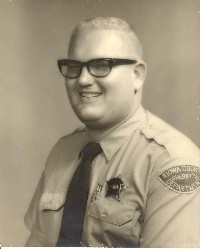
|
Max Gordon Straub - Deputy Sheriff
Kiowa County Sheriff’s Office
Max Straub was born January 9, 1948, in Elk City, Oklahoma to Elmer Chritian and Margaret Elizabeth (Mitchell) Straub.
In 1969 Max Straub married Quintena Lecklider.
Also, in 1969 Max Straub joined the Mangum Police Department where he served until joining the Kiowa County Sheriff’s Office in January 1973.
On the afternoon of Wednesday, May 2, 1973, Max Straub had been a Deputy Sheriff less than four months when twenty-two-year-old, Charles Stinson, walked into the Kiowa County Sheriff’s Office in Hobart and asked to be taken to the Western State Hospital in Fort Supply to be committed voluntarily for mental evaluation.
Shortly after 3:00 p.m. Deputy Sheriff Max Straub, 25, left Hobart transporting Charles Stinson to Fort Supply without handcuffing him. A few hours later, Deputy Sheriff Max Straub’s dead body was found in his patrol car at the intersection of U. S. Highways 60 and 83, two miles north of Seiling. Deputy Sheriff Max Straub had been shot in the head and chest with his own .357 Magnum revolver. Witnesses reported seeing two men struggling in the car, hearing shots fired and seeing Charles Stinson running away. About seventeen minutes later, Charles Stinson was apprehended walking along the highway.
Deputy Sheriff Straub was survived by his wife Quintena and eleven-month-old son Michael.
Max Straub is buried in Roselawn Cemetery, Mangum, Greer County, Oklahoma.
Charles Stinson was convicted of the murder of Deputy Sheriff Max Straub and sentenced to life in prison where he died in 1991.
OLEM – 1N-3-7 (Staub) NLEOM – 14E1
January 10, 2023
|
|
|
|
|
|
Charles H. Strickland – Territorial Sheriff
Chickasaw Nation, Indian Territory
Charles H. Strickland was born April 8, 1837. In 1861 Charles Strickland enlisted in Company A of the Confederacy’s First Choctaw and Chickasaw Mounted Rifles, raising to the rank of Second Lieutenant before the Civil War ended.
When Indian Territory was opened to the white settlement, Charles Strickland became the first elected Sheriff of the Chickasaw Nation. On Tuesday, March 19, 1895, Strickland and Bill Lewis were riding together in a buggy near Byrd’s Mill, close to present day Pauls Valley. It has been reported that Bill Lewis killed Sheriff Strickland over an old grudge. After Lewis killed Strickland, Lewis took his body to the home of Sheriff Strickland’s daughter, Elizabeth, and dumped it over her fence. Judge Billy Perry issued a writ of arrest for Bill Lewis. The Indians came from all over for Strickland’s funeral, playing drums and dancing the dance of the dead all night.
Charles Strickland is buried in Frisco Cemetery, Frisco, Pontotoc County, Oklahoma.
OLEM – 5N-2-3 Not a Line of Duty Death
July 14, 2022
|
|
|
|
|
|
Charles H. Stricker - Chief
Commerce Police Department
About 10 p.m. on Wednesday, October 22, 1919, Chief Charles Stricker, 58, was patrolling Main Street when he noticed a car fitting the description of a recently stolen car from Miami coming down the street. Chief Stricker stepped to the street and attempted to halt the car. Instead, the car sped up. Chief Stricker fired at the wheels of the car as it passed him. The driver of the car then fired at Chief Stricker, striking him once in the chest near the heart and once in the right leg. Chief Charles Stricker fell to the street and died.
Chief Charles Stricker was survived by his wife Mattie and adult daughter Mable and is buried in Forest Park Cemetery, Joplin, Jasper County, Missouri.
Earl Blanchard and his wife Vida were later convicted of Chief Charles Stricker’s murder and sentenced to life in prison. Their conviction was reversed in 1922 by the Oklahoma Criminal Court of Appeals and a new trial ordered for each.
OLEM – 10S-2-8 NLEOM – 53E23
January 10, 2023
|
|
|
|
|
|
Kenneth Wayne Stump, State Trooper
Oklahoma Highway Patrol
Trooper Stump was born in Andrews, Texas, on July 16, 1947. After serving in the military from 1965-1973, including a tour in Vietnam, he joined the OHP in 1974.
Stump was assigned to the Turner Turnpike when, on Sunday, November 19, 1984, neighbors found his dead body in his patrol car in the driveway of his home near Beggs. He apparently was preparing to go on duty when he suffered a fatal heart attack. Stump, 37, was survived by his wife, a son, and a daughter.
Trooper Kenneth Stump’s name was engraved on the Oklahoma Peace Officers Memorial though his death is not considered a line of duty death.
OLEM – 2N-2-15
July 14, 2022
|
|
|
|
|
|
W. W. Sublett – Deputy U.S. Marshal
U.S. Marshal Service
In contemporary accounts of this incident this deputy marshal’s name is stated as both H. W. Sublett and W. H. Sublett. In 1905 Sublett was serving as resident Deputy Marshal in Mill Creek, near Tishomingo in present Johnson County.
About 10:30 p.m. the evening of Wednesday, August 30, 1905, Deputy Marshal Sublett had just returned to Mill Creek on the south bound train. As Deputy Marshal Sublett entered the yard of his home in the eastern part of town, he was knocked down by a shotgun blast from ambush by an assailant hidden behind the fence of the yard. Most of the blast was absorbed by the deputy marshal’s gun belt but some pellets entered his side, and his left hand was almost severed. Deputy Marshal Sublett got up and charged his assailant but was unable to prevent his escape.
Deputy Marshal Sublett survived his wounds but was permanently disabled and resigned his deputy marshal commission on September 26, 1905.
A man named Jeff Gilstrap was arrested in Ardmore on November 23rd and charged with assault with intent to kill. It was believed Jeff Gilstrap’s motive for shooting Deputy Marshal Sublett involved a dispute over a woman named Dovie Deaver.
OLEM – 5N-4-17 (WW)
July 14, 2022
|
|
|
|
|

|
Houston F. “Pappy” Summers - State Trooper
Oklahoma Highway Patrol
On Friday morning, May 26, 1978, the nationwide search for two escaped convicts, Claude Eugene Dennis, 35, and Michael Charles Lancaster, 25, centered around Lake Texhoma. The pair had escaped from the Oklahoma State Penitentiary in McAlester thirty-four days earlier. Since then the pair had engaged in a crime spree that covered 1,000 miles from Oklahoma to Alabama and included seven murders. They also had wounded a police officer in Alabama. Highway Patrol (OHP) Troopers were sent from all over Oklahoma to assist in the search.
That morning a farmer in Kenefic reported that two heavily armed men tied him up and stole his pickup truck. The description of the pickup was broadcast to all units in the area.
OHP Troopers Houston F. “Pappy” Summers, 62, and Billy Gene Young, 50, located the pickup on Highway 48 eight miles north of Durant and pursued it north to near Kenefic. The pickup finally pulled over to the side of the road. As the troopers patrol unit came to a stop behind the pickup the two convicts opened fire on them. Both Trooper Summers and Young were killed.
The convicts then traveled east on Highway 22 into Caddo with their location being broadcast by an OHP airplane that was following them overhead. Once in Caddo the pickup pulled into a driveway on Court Street, the two convicts jumped out and hid behind some nearby shrubbery. Almost immediately, an unmarked OHP unit pulled up in front of the driveway driven by Lt. Hoyt Hughes with his partner, Lt. Pat Grimes, 36. The convicts opened fire on the troopers immediately, killing Trooper Grimes. Trooper Hughes was also wounded but after emptying his pistol retrieved a semi-automatic rifle from his dead partners lap and emptied it at the convicts, killing Lancaster. Other troopers soon arrived and in the continuing shootout killed Dennis. Trooper Summers was preparing to retire after serving thirty-two years when he was killed.
Trooper Houston Summers was survived by his wife Loree Rose.
Houston Summers is buried in Memorial Park Cemetery, Enid, Garfield County, Oklahoma.
May 26, 1978, “Black Friday” was the worst day in the 40-year history of the OHP, however less than two months later three more troopers would die in the line of duty.
OLEM – 1N-3-24 NLEOM – 43W12
|
|
|
|
|
|
Robert William “Robby” Sumner – Corporal
Oklahoma Department of Corrections July 14, 2024
Robert W. (Eatherly) Sumner was born May 4, 1993, in Okmulgee, Oklahoma.
Robert (Eatherly) Sumner graduated from the Oklahoma Department of Corrections (ODOC) Academy in November 2023, and was assigned to the John Lilly Correctional Center (JLCC) in Boley.
At Approximately 5:22 a.m. on Sunday, July 14, 2024, Corporal Robert Sumner was driving an ODOC van on Highway 62, one mile east of Meeker near 3450 Road on his way to OU Medical Center in Edmond to work a hospital shift. At the same time ODOC Corporal Andrew Freppon was driving his personal vehicle in the opposite direction on Highway 62 on his way to JLCC for his regular duty shift when both corporals’ vehicles collided head-on.
Corporal Robert Sumner was pronounced dead at the scene. Corporal Andrew Freppon was Medi flighted from the accident scene to OU Medical Center in Oklahoma City.
Corporal Robert Sumner was survived by his pregnant wife Autumn Rain and his young son from a previous marriage, Avry Eatherly.
Robert Sumner’s earthly remains were cremated.
OLEM – 12S-1-3 NLEOM – 21-WT-1
Updated May 2, 2025
|
|
|
|
|
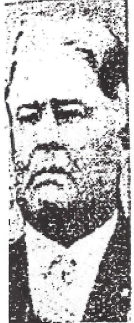
|
Robert Osborne “Bob” Sumter - Deputy U.S. Marshal
U.S. Marshal Service
On Wednesday, August 9, 1933, Deputy Marshal Robert Sumter left his home in Ada and drove to Coalgate stopping at the Mayer Meat Market to pick up his friend Paul Mayer to ride along while he served some court papers. The two men rode south on Highway 75 toward Lehigh, four miles south of Coalgate. The men stopped and asked for directions to Frank Kosack’s place. Deputy Marshal Robert Sumter drove his car to within a half mile of the Frank Kosack home and told Paul Mayer to wait in the car. Around 3:00 p.m. Deputy Marshal Robert Sumter set out on foot up a small trail. Paul Mayer waited an hour and then became concerned and went looking for his friend Deputy Marshal Robert Sumter. Paul Mayer soon came upon a working still and the body of Deputy Marshal Robert Sumter, who was lying face down in a twisted position. Paul Mayer ran back to the car and drove the deputy marshal’s car into Lehigh where he called the Sheriff, asking that officers and an ambulance be sent to the scene.
Sheriff Clark and several deputies responded, as did the county attorney and Justice of the Peace, E. Pritchard. When the lawmen examined Deputy Marshal Robert Sumter, they noticed that his gun was missing. They knew he was right-handed and noticed that he was clutching a smoking pipe in his right hand. Deputy Marshal Robert Sumter had been shot at least six times with shotgun wounds to his chest, back, abdomen, face, neck and top of the head. Paul Mayer had returned to the scene and informed the officers that he had seen nineteen-year-old John Cisco running in the area shortly before he had found Deputy Marshal Robert Sumter’s body. John Cisco was immediately picked up for questioning. John Cisco quickly implicated his brother Tom Cisco, as well as Barnard Blue, John Gruber, Will Smith and Oscar Lovingood. John Cisco stated that as Deputy Marshal Sumter approached the still, they all ran except Oscar Lovingood. John Cisco also stated Oscar Lovingood had a shotgun when he was last seen.
Deputy Marshal Robert Sumter was survived by his wife, Lena, a daughter, Cleo, and a son, Robert O. Jr. and is buried in Westview Cemetery, Atoka, Atoka County, Oklahoma.
Around 7:00 a.m. the next morning, August 10, 1933, Oscar Lovingood was arrested about twenty miles from the scene. Lovingood offered no resistance and was easily arrested. During the arrest Lovingood said he had fired in self-defense when the lawman had fired on him first.
On Wednesday, August 16th a preliminary hearing was held for all the defendants. Charges were dismissed on all except Oscar Lovingood. The Judge found probable cause to believe a crime had been committed and that probable cause existed to believe that Oscar Lovingood had committed the crime of murder.
After two hung juries, Oscar Lovingood was finally convicted in June 1935 and sentenced to forty-five years in prison.
In October 1935, Oscar Lovingood was also tried in federal court. Lovingood was found guilty and was sentenced to serve ten years in Leavenworth Federal Prison.
Oscar Lovingood was paroled from the Oklahoma State Prison in March 1952, only after the death of Deputy Marshal Robert Sumter’s widow.
OLEM – 7N-1-4 (Sumpter) NLEOM – 42W14
August 7, 2021
|
|
|
|
|
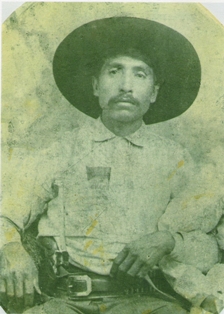
|
Jesse “Jess” Sunday - Sheriff
Saline District, Cherokee Nation
Jesse Sunday was just completing a term as Sheriff of Saline District and his half-brother, Dave Ridge, had been elected to take his place. The Saline District of the Cherokee Nation was in what is now part of Mayes and Delaware Counties in Oklahoma.
About noon on Sunday, September 20, 1897, Sheriff-Elect Dave Ridge was on his way to the Baggett store to pick up some items his wife had sent him for. Ridge ran into some friends and had several drinks with them. Realizing that it was late, about 6:00 p.m., and he still needed to get the items from the store, Ridge headed over to the Baggett store which was closed. Desperate to get the items for his wife, he began banging on the door to the store. Tom Baggett and his family lived above the store. Baggett leaned out of the window above the store and told Ridge to leave because he was drunk. Baggett had closed the store early that day due to the rowdy drinking of several men and a warning there might be trouble later. As Ridge and Baggett argued over the closed store, a shot came from across the street hitting Baggett and killing him. Ridge stayed around with a gathering crowd to help Mrs. Baggett and her four daughters.
About an hour later, two witnesses, one of whom was Jesse Sunday’s son, Andy, and Dave Ridge met two men on a trail about 200 yards away from the shooting scene. The two men were Sampson Rogers and Wilson Towery. Ridge confronted Rogers with the fact that he had seen him fire the shot that killed Baggett. Rogers, enraged, then hit Ridge over the head with a whiskey bottle. Andy Sunday then stepped out and got the men to leave his uncle alone. Dave Ridge died from his head injuries that night.
Sheriff Jesse Sunday was then ten miles east of Saline guarding some prisoners when the killings occurred. Notified of the murders, he rode to Saline and began investigating. He deputized several men including Wilson Towery and Cooie Bolin, both of whom had witnessed the Ridge murder. Sunday and Bolin went to the nearby home of Jim Teehee to see if anyone there had witnessed anything. John Colvard and Martin Rowe were sitting on the porch, Colvard with a rifle across his lap. Sunday took the rifle away from Colvard without resistance, talked with the men and was told they knew nothing of the killings.
Bolin and Sunday walked back to their horses when Rowe opened fire on them hitting Sunday. Sunday dropped Colvard’s confiscated rifle, Bolin picked it up and began firing at the fleeing Martin Rowe while the wounded Sheriff Sunday was trying to catch his horse.
Andy Sunday found his wounded father by a tree near the Teehee home the next morning. He took him to the Teehee home where the sheriff died that night.
Jesse Sunday was survived by his wife Alice and six children and is buried in Elm Grove Cemetery, Rose, Mayes County, Oklahoma.
Martin Rowe surrendered himself a month later. He was arrested, tried, and convicted of Sunday’s murder. Originally sentenced to death, the sentence was later commuted to ten years in prison at Tahlequah. Three months later Rowe escaped and went to west Texas, later joining the Army. While in the Army all charges were dropped, and he came out of the Army a free man.
OLEM – 3S-1-3 NLEOM – 55W23
September 20, 2020
|
|
|
|
|
|
Jeffferson Davis “Jeff” Surratt – Sheriff
San Bois County (Haskell County), Choctaw Nation, Indian Territory
San Bois County, Choctaw Nation
On December 3, 1900, Sheriff Jeff Surratt, 45, of San Bois County in the Choctaw Nation found one of his deputies, N.M. Woolridge, a half-breed Choctaw, drunk. While Sheriff Surratt was trying to calm his deputy, Woolridge drew his gun and shot the sheriff through both lungs. Sheriff Jeff Surratt died two days later December 5th and Deputy N. M. Woolridge was charged with his murder.
Sheriff Jeff Surratt was survived by his second wife Fena and is buried in the Whitfield Cemetery, Whitfield, Haskell County, Oklahoma.
OLEM – 9N-3-9 NLEOM – 7W19
July 11, 2022
|
|
|
|
|
|
John Swain – Deputy U.S. Marshal
U.S. Marshal Service
Not a Line of Duty Death
John Swain was born in Missouri about October 12, 1861. Before coming to the Indian Territory in the winter of 1883, John Swain lived in Tennessee then in his youth worked as a cattleman on the XIT ranch in Texas. John Swain first settled in Carter County in the town of Dresden (which was renamed Berwyn in 1887) which at the time was the end of the Santa Fe Railroad. The town of Berwyn years later was renamed Gene Autry after the popular western movie star and singer.
In Dresden John Swain worked as a cowboy for Ed Colbert, the nephew of the Governor of the Chickasaw Nation.
Following his acquittal on the grounds of self-defense on the charge of murder in Judge Parker’s Court at Fort Smith for the shooting death of George Donahoe over a card game on January 24, 1887, in Dresden, John Swain was recruited as a posse for Deputy U.S. Marshal Heck Thomas. John Swain worked as Thomas’ Posse for a couple trips into the Indian Territory.
One source states John Swain was Deputized as a Deputy U.S. Marshal in 1887, however his first oath of office recorded at the National Archives was dated February 20, 1889.
John Swain developed a reputation as an active, fearless officer and a dangerous man to resist. After eight years of service John Swain resigned his Deputy U.S. Marshal commission near the end of 1894, as he was “tired of living by the gun” and wanted to settle down with his second wife. John Swain’s first wife, a Chickasaw Indian, had died years earlier of a lung disease and the marriage had conferred Chickasaw citizenship on him. John Swain had met his second wife through returning stolen property stolen by the Hudgins outlaw gang.
In 1894, John Swain became involved in a dispute bitter between Carl Vincent, his son Charley, and a negro family over some property near Swain’s farm sixteen miles south of Purcell.
On January 9, 1895, John Swain, 33, was riding near his home with his father-in-law, T. G. Ryan, following a short distance behind in a wagon. The men were intending to butcher a cow and share the beef. It was cold and Swain was wearing a heavy coat buttoned up over his gun and heavy gloves. Swain was stopped on the trail by Carl Vincent, his son Charley, and Jim Colbert. T. G. Ryan was not close enough to hear what was said but a violent argument developed. As John Swain started to ride away, Carl Vincent shot him in the upper body with a Winchester rifle. John Swain fell from his horse and as Swain was laying on the ground, Carl Vincent approached and hit Swain with the butt of his rifle. John Swain was able to pull his gun and fatally shoot Carl Vincent. Charley Vincent, 22, then shot and killed John Swain.
John Swain was buried in Hillside Cemetery, Purcell, McClain County, Oklahoma.
Charley Vincent was tried in Paris, Texas for the murder of John Swain.
OLEM – 5N-3-14
July 16, 2022
|
|
|
|
|
|
Oliver Swan - Deputy City Marshal
City of Wilburton
At 11 p.m. on Monday, September 23, 1907, Deputy City Marshal Oliver Swan, 20, arrested a black man named W.A. Johnson near the Wilburton Depot on a warrant for failure to pay a $3 fine, a trivial offense. W. A. Johnson indicated that he might resist arrest and Deputy City Marshal Oliver Swan drew his gun. Johnson asked Deputy Marshal Swan if he would shoot him over a $3 unpaid fine and told Swan if he would put the gun away, he would go peacefully. Deputy City Marshal Oliver Swan lowered his gun and W. A. Johnson instantly drew a weapon firing at Swan three times. Two of the three shots struck Deputy City Marshal Swan in the head and neck, killing him.
W. A. Johnson then stole a horse and escaped.
Oliver Swan is buried in Wilburton City Cemetery, Wilburton, Latimer County, Oklahoma.
The town’s folks offered a $1,000 reward to which the Governor added another $300 for the capture of W. A. Johnson. Johnson eluded officers until June of 1908 when he was spotted walking along the Rock Island tracks at the edge of town dressed in women’s clothing. Sheriff Mickle recognized Johnson and gave the alarm. Johnson threw off the female attire, drew a rifle and began shooting at Sheriff Mickle. Mickle returned fire but Johnson ran toward the mountains. Within ten minutes every man who could secure arms joined the manhunt. Upon reaching Brandy Creek, Johnson came upon two fishermen who he shot and killed thinking they were part of the posse. A four-man posse headed by Ben Nowlin, a farmer, found W. A. Johnson and in the gun fight that followed W. A. Johnson was shot and killed.
OLEM – 3S-1-11 NLEOM –
September 23, 2021
|
|
|
|
|
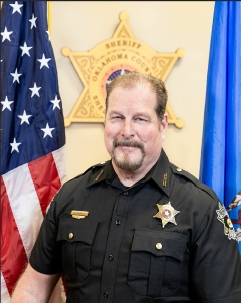
|
Robert Blaine "Bobby" Swartz - Sergeant
Oklahoma County Sheriffs Office
Robert Swartz was born January 15, 1964, in Albuquerque, New Mexico to Sam Swartz and Phyllis Maxey. Robert was lovingly raised by his mother Phyllis and stepfather Ernie Maxey. Robert attended Northwest Classen High School in Oklahoma City. After graduating high school Robert joined the U.S. Army Reserves and later went to work in the Oklahoma County Jail. In December 1997, Robert was sworn in as a Deputy Sheriff with the Oklahoma County Sheriff’s Office.
Robert served the citizens of Oklahoma County for almost twenty-five years as a Deputy Sheriff and was promoted to Sergeant in February 2022.
Just after 1:00 p.m. on Monday, August 22, 2022, Sergeant Robert Swartz, Deputy Sheriff Mark Johns, and Deputy Sheriff Melody Norton went to the residence at 2221 SW 78th Street in Oklahoma City to serve a lock out eviction warrant on Benjamin Plank, 35. The deputies contacted Plank at the front door then Sergeant Swartz and Deputy Johns went around to the back of the residence. As the deputies entered the back yard Benjamin Plank opened fire on them with a rifle. Sergeant Robert Swartz was struck twice, Deputy Sheriff Johns immediately covered Sergeant Swartz and was himself struck by two bullets. Upon hearing the gun shots Deputy Sheriff Melody Norton ran to the back yard where she was fired upon and returned fire toward the back door of the residence.
Benjamin Plank was able to escape the residence in a white Dodge pickup pulling a boat after he had placed a bag containing numerous firearms in the boat and had the rifle and other firearms in the cab of the pickup.
Oklahoma City Police officers received numerous calls at 1:18 p.m. reference shots being fired at the residence on SW 78th Street. Upon arrival police officers found the two wounded deputies in the back yard. Both Sergeant Swartz and Deputy Sheriff Johns were transported by ambulance with a police escort to OU Hospital.
About 1:30 p.m. Oklahoma City Police spotted Benjamin Plank’s white Dodge pickup not far from the shootings. Officers pursued the pickup east on I-240 to I-35 then north on I-35. Benjamin Plank fired several shots at pursuing officers with his rifle during the pursuit. About SE 15th Street two Oklahoma City Police Officers were able to fire at Plank with rifles striking the windshield of the speeding north bound white pickup. Benjamin Plank continued driving north on I-35 then east on I-40 with officers still in pursuit. Plank exited I-40 at the S. Air Depot exit in Midwest City then turned south on S. Air Depot coming to stop at the gate to Tinker Air Force Base. Plank dropped his rifle out of the driver’s side window, exited the pickup and was taken into custody by Oklahoma Highway Patrol Troopers, Oklahoma City Police Officers, and other officers.
Sergeant Robert Swartz was pronounced dead shortly after arriving at the hospital. Deputy Sheriff Mark Johns was treated for the two-gunshot wounds to his lower abdomen area. All four rifle shots had missed striking both deputies’ ballistic vests.
Sergeant Robert Swartz was survived by his son Austin, his wife Kim, and their children Raegan and Rowan.
Robert Swartz is buried in Resthaven Cemetery, Oklahoma City, Cleveland County, Oklahoma.
Deputy Sheriff Mark Johns survived his gunshot wounds.
OLEM – 10S-1-20 NLEOM – 40W34
April 19, 2023
|
|
|
|
|
|
Jim Sweatte – City Marshal
City of Keokuk Falls
The town of Keokuk Falls was located four and a half miles north and fifteen miles east of Shawnee in Pottawatomie County. It was one mile west of the Creek Nation and one mile north of the Seminole Nation across the North Canadian River. The town became one of the most famous liquor towns in Oklahoma because it was in the “wet” Oklahoma Territory near the “dry” Indian Territory.
In 1904, Jim Sweatte was the first town marshal of Keokuk Falls, one of the most lawless, wide open border towns.
One of the “Seven Deadly Saloons” was owned by Big Ed Thomlinson, who was so nicknamed because of his six-foot four-inch height and his weight of two hundred and fifty pounds. Big Ed Thomlinson and Jim Sweatte became involved in a personal dispute over an alleged affair with Jim Sweatte’s daughter. Jim Sweatte went for his gun and Big Ed Thomlinson killed him. During the trial, Thomlinson was acquitted because Jim Sweatte had drawn his gun first. Such was the justice of Oklahoma Territory.
Unjust perhaps, but at least it was usually consistent. In 1905, Big Ed Thomlinson was killed in a gun fight by a man named Felix Grundy. Some people said Thomlinson was unarmed and others said Thomlinson’s wife had picked up his gun after the shooting and hidden it. In his trial, Gundy was acquitted because of “conflicting testimony.”
OLEM – 1N-2-25
August 29, 2022
|
|
|
|
|
|
Marion A. Sweeten - Deputy U.S. Marshal
U.S. Marshal Service May 3, 1886
Marion A. Sweeten, was appointed a Deputy U.S. Marshal of the Western District of Arkansas in Ft. Smith, Arkansas, and lived in Oklahoma with his wife, Harriet, and son, John Alexander Sweeten born in 1866. They farmed a piece of land in what is now Haskell County and had another couple living with them, the Wilburn’s. Wilburn had married a niece of Sweeten and worked the land with the Sweetens. Wilburn was also Sweeten’s posse.
On Monday evening, May 3, 1886, Wilburn was beating his wife when Marion Sweeten interfered. Wilburn grabbed a rifle and shot Marion Sweeten in the chest, killing him instantly. John Sweeten, now twenty years old, heard the shooting and started to run from the area when Wilburn shot at him. The shot missed and John kept running stopping at a neighbor’s house three miles away.
The following morning, John returned, along with several other men. No one was in the house when they arrived, and they searched the surrounding area. They found Deputy Marion Sweeten’s body at the bottom of the well. The men were able to raise Marion Sweeten’s body out of the well and noticed there were scratches and scuffmarks on the dead man’s face indicating he had been dragged.
There was no sign of Harriet Sweeten and the group started a search in the area, finding her dead body concealed under some brush two hundred yards from the house.
Wilburn and his wife had fled, taking their personal belongings with them. John noted two horses, as well as two rifles and Marion Sweeten’s handgun were missing.
The nearest Deputy U.S. Marshal was notified and arrived on the scene, examining the bodies as well as the house for any evidence as well as any trace of the Wilburn’s.
Marion and Harriet Sweeten were buried at Whitefield Cemetery, Whitefield, Haskell County, Indian Territory (Oklahoma).
No record was ever found indicating that Wilburn was ever arrested.
John Sweeten continued to live in the Indian Territory, married and had a son who moved to Texas. John’s son, Jess Sweeten, followed his grandfather into law enforcement, serving for twenty-two years as County Sheriff of Henderson County, Texas.
OLEM – 9N-2-22 NLEOM –
Updated March 10, 2024
|
|
|
|
|
|
J.H. Swinford – City Marshal
Kiefer
The afternoon of Monday, August 16, 1909, two men dressed as cowboys arrived in Kiefer. Their actions of looking over the Kiefer State Bank aroused the suspicion of City Marshal J. Henry Swinford. Bank officials were notified that their bank might be robbed (burglarized) later that night.
Bank cashier Palmer Wedding, a Dr. Jones and a man named R. Bailey quietly entered the bank that evening. About 10 p.m. Cashier Palmer Wedding and one of the other men went outside to look around. They noticed the two suspicious men setting on a pile of bricks at a building under construction next door. When the two suspicious men saw the other men, they left the building. City Marshal J. Henry Swinford was notified.
About 11 p.m. City Marshal Swinford, 29, located the two men on a side street near the bank and drew his gun on them ordering them to surrender. One of the men stepped back into a darkened area. Cashier Palmer Wedding seeing the city marshal ran to his assistance. Before Palmer Wedding reached City Marshal Swinford a shot rang out from the darkened area and the city marshal fell dead with a gunshot to his head. Just as Palmer Wedding got to the city marshal’s body he was shot in the back. Palmer Wedding was put on a train to Tulsa for treatment of his wound. The body of City Marshal J. Henry Swinford was taken to Sapulpa for burial.
J. Henry Swinford was survived by his wife Cora and two young sons, James Rufus, 2, and T. R. “Ted” 4 months old.
J. Henry Swinford is buried in Twin Mounds Pioneer Cemetery, Glenpool, Tulsa County, Oklahoma.
Two men, giving their names as W. D. Dickson and J. B. Austin, were soon arrested for the murder of City Marshal J. Henry Swinford.
OLEM – 10N-1-3 NLEOM – 36W27
July 14, 2022
|
|
|
|
|
|
Mark Eyre Switzer – Patrolman
Pawhuska Police Department
Mark E. Switzer was born December 24, 1897, in Chillicothe, Livingston County, Missouri to William M. and Eva Lena Lee (Logan) Switzer.
In 1923 Mark E. Switzer married Hattie Virginia Drilling.
On January 12, 1927, at approximately 1:45 a.m., Pawhuska Police Officers Mark E. Switzer, 29, and Dutch Maze observed Clem F. Edens driving down a street in Pawhuska. Suspecting that Edens was hauling illegal whiskey, the officers followed him until Edens pulled into the driveway of his home.
Officers Switzer and Maze approached the Eden car, Switzer on the right and Maze on the left. “Get out Clem and let’s see what you’ve got” Officer Maze is reported to have said. Instead of getting out on the left side, Edens is alleged to have left the car on the right side and upon seeing Officer Mark Switzer, fired at him.
Officer Mark Switzer dropped to the ground mortally wounded with a bullet through the chest near his heart and died before an ambulance could reach him.
Patrolman Mark Switzer was survived by his wife Hattie and one year old son Donald Eyre Switzer.
Mark Switzer is buried in Pawhuska City Cemetery, Pawhuska, Osage County, Oklahoma.
Clem Edens was charged with first degree murder in the death of Officer Mark Switzer.
OLEM – 4S-3-3 NLEOM – 24W23
January 10, 2023
|
|
|
|





